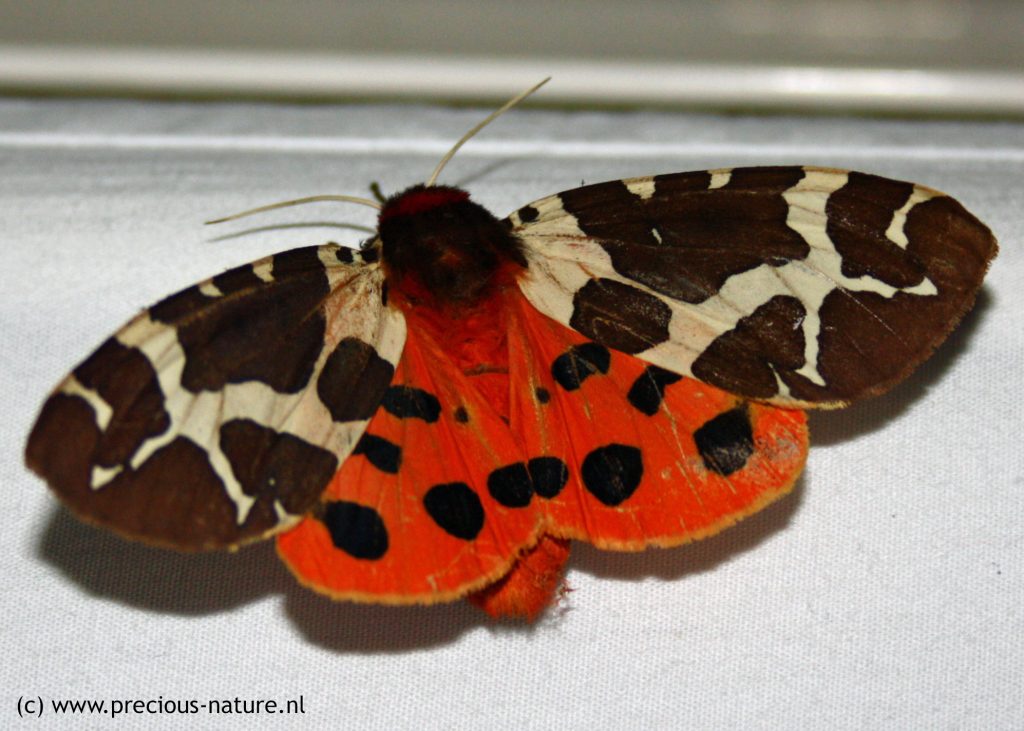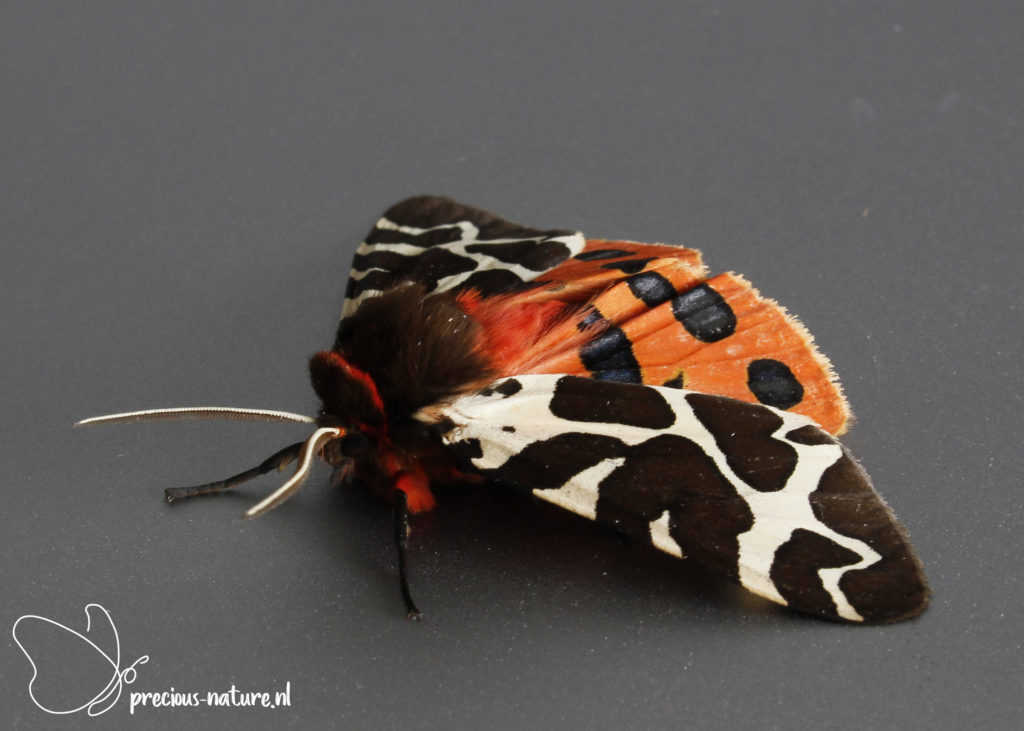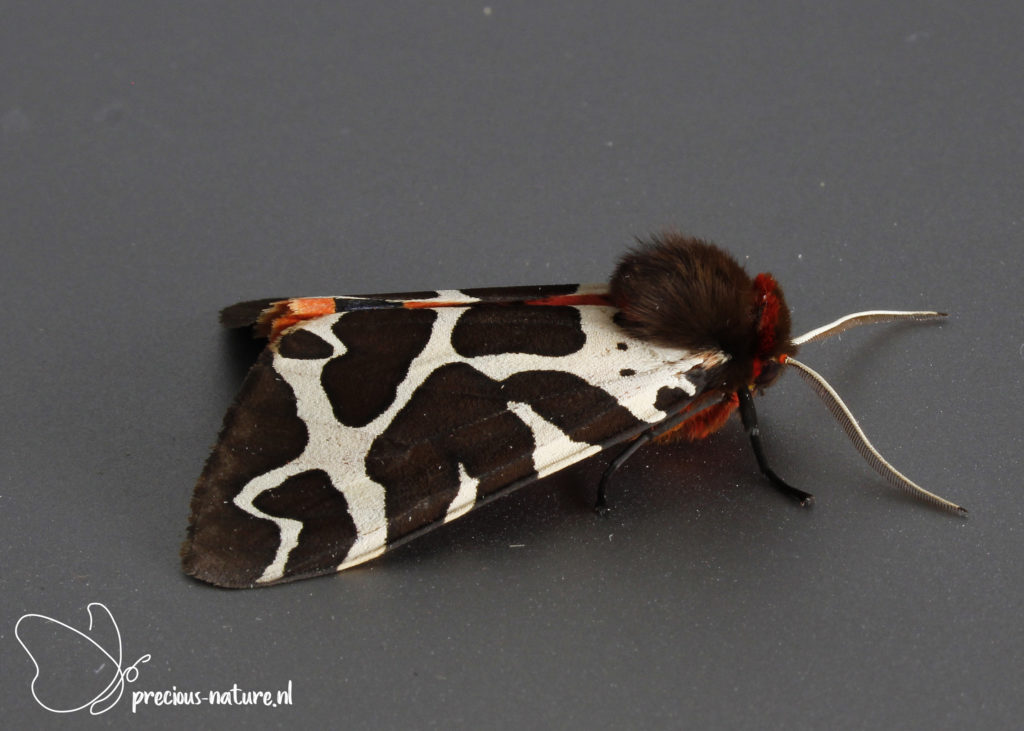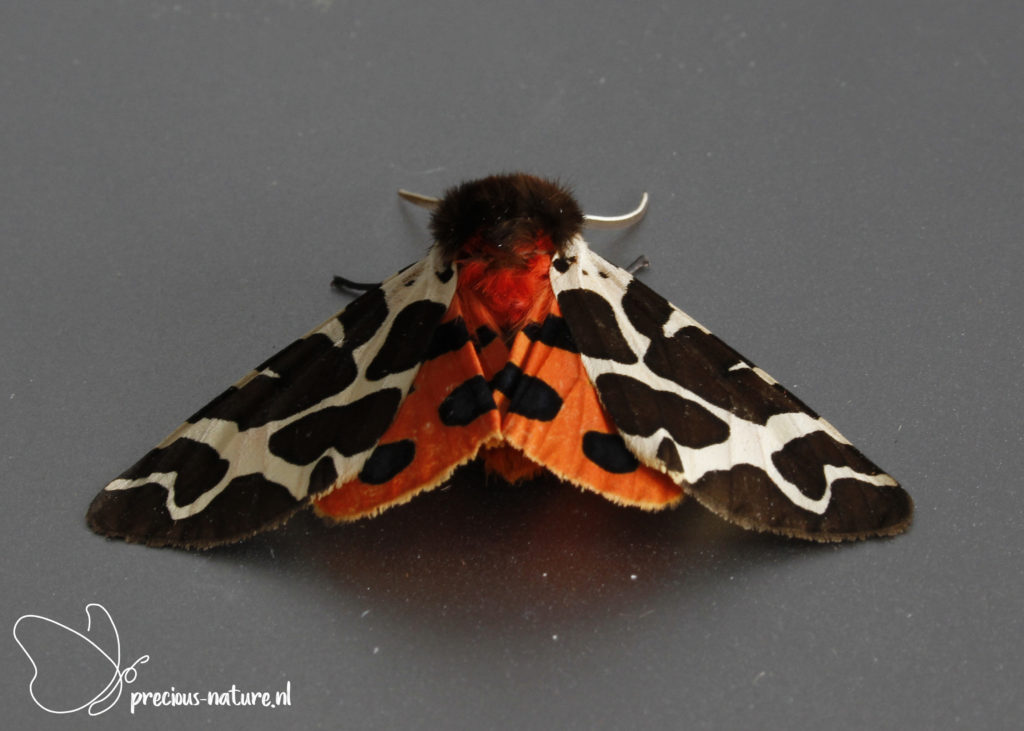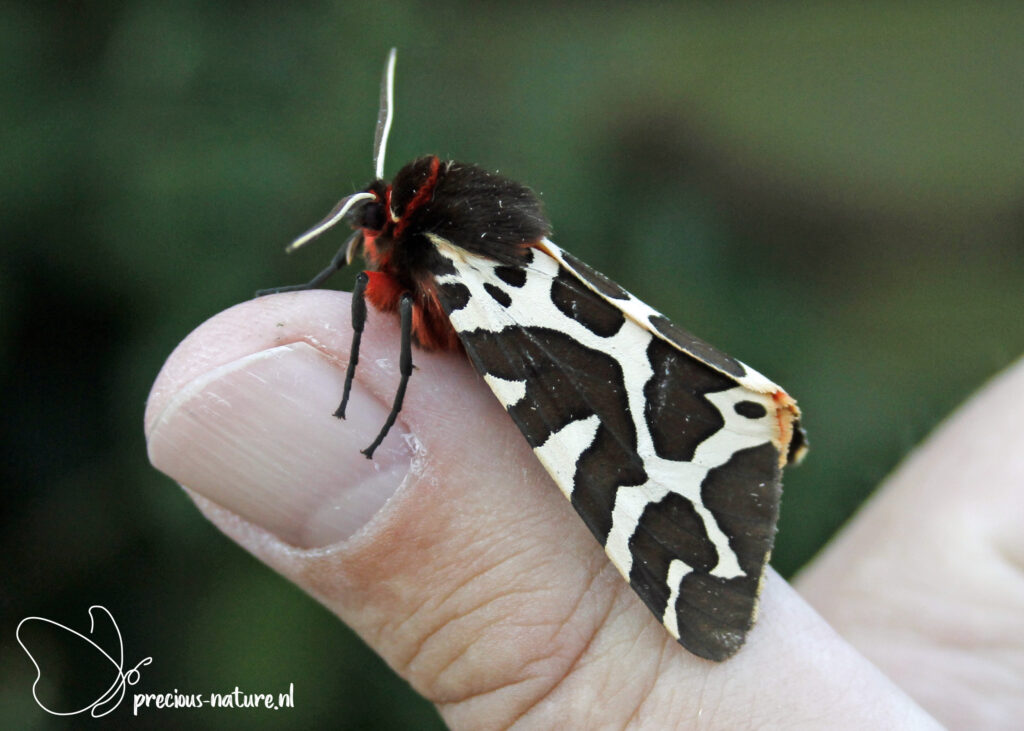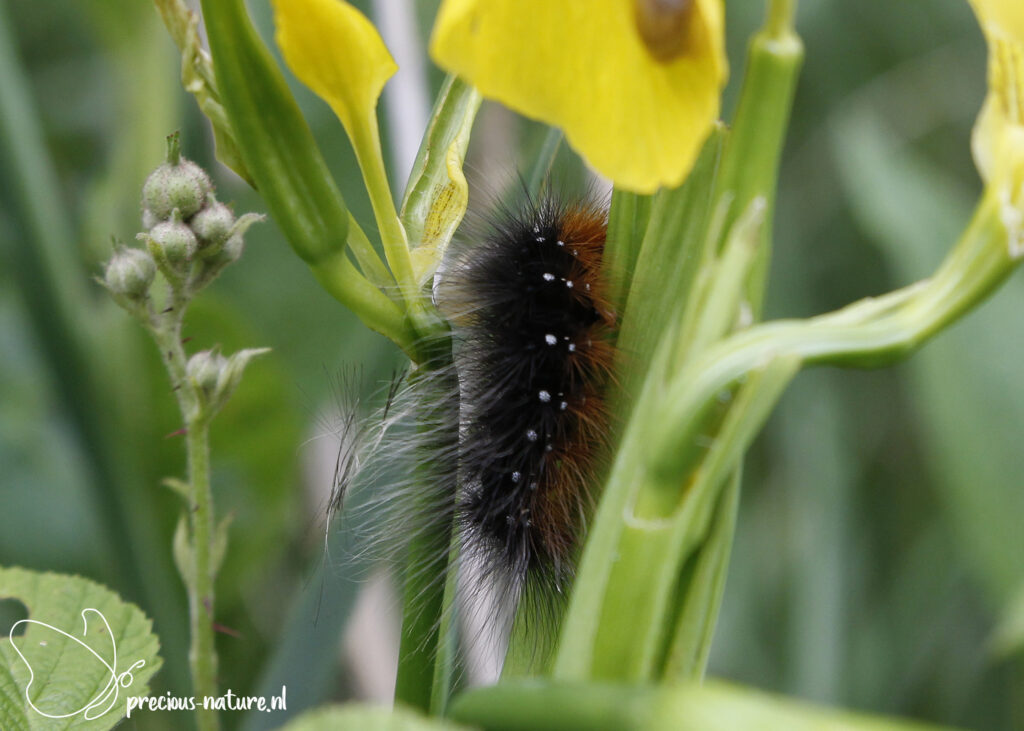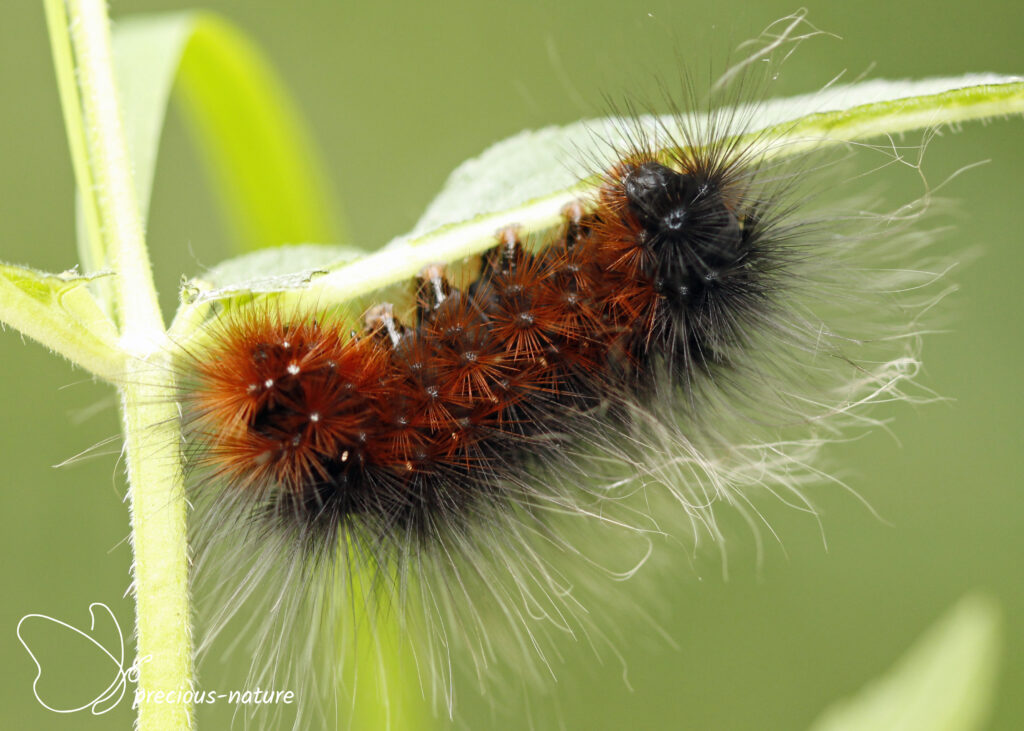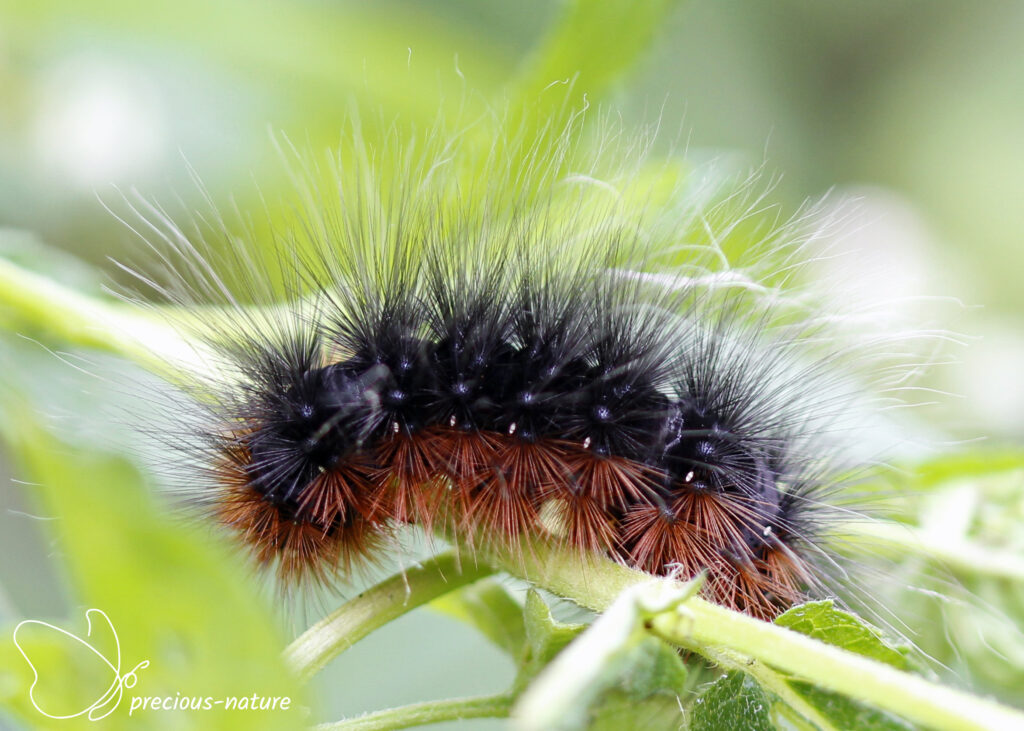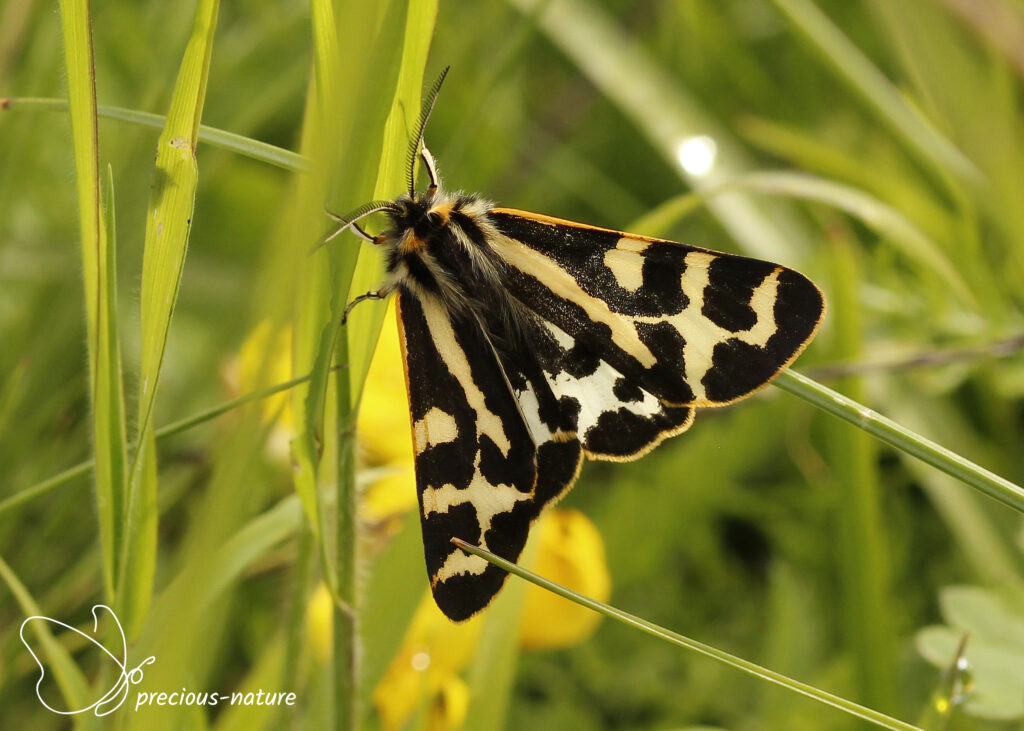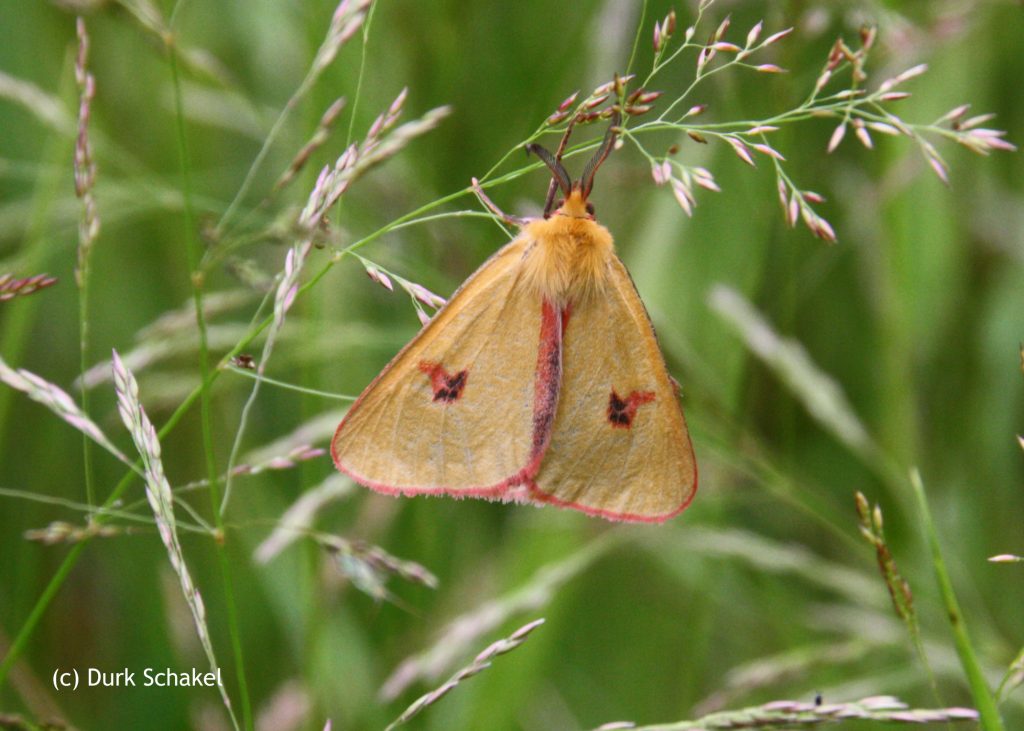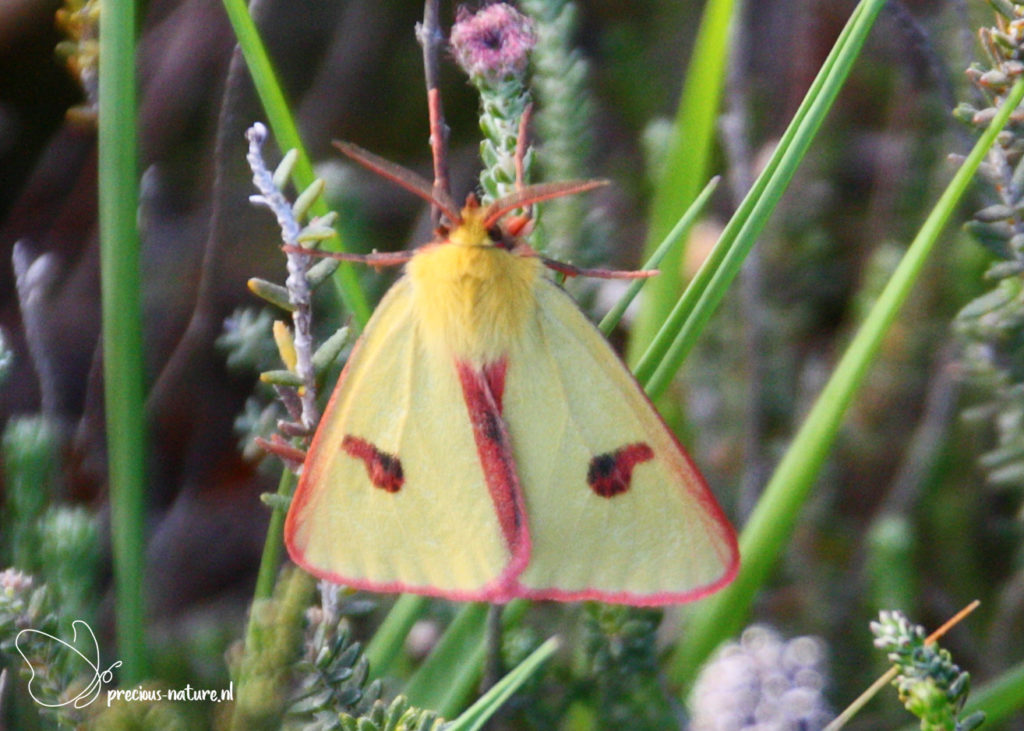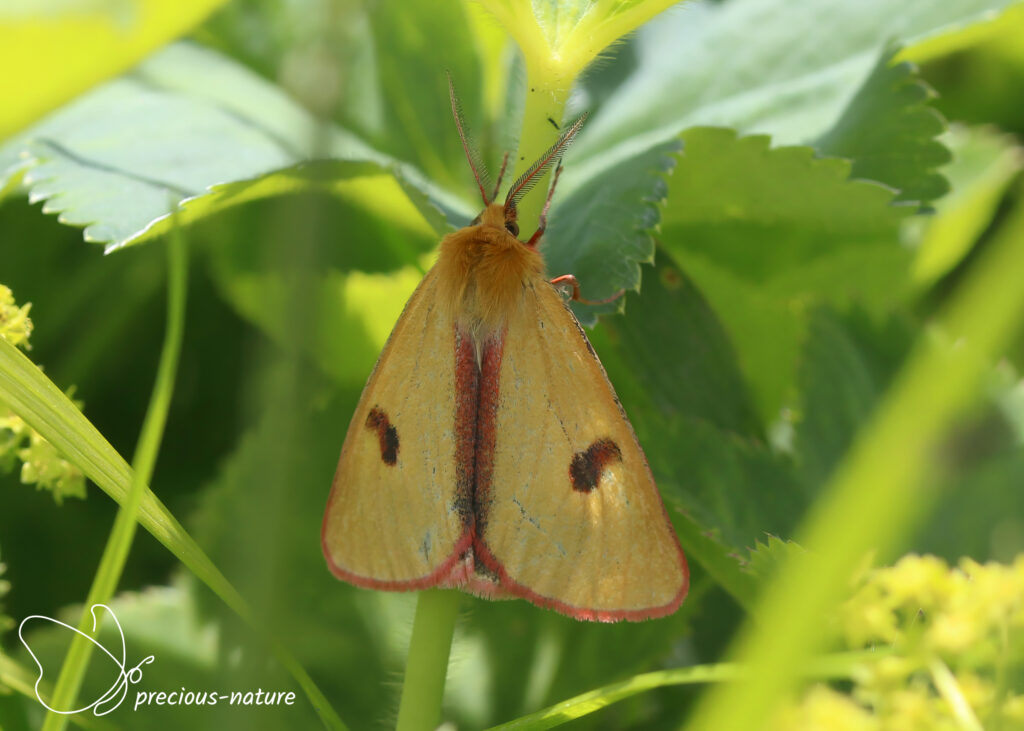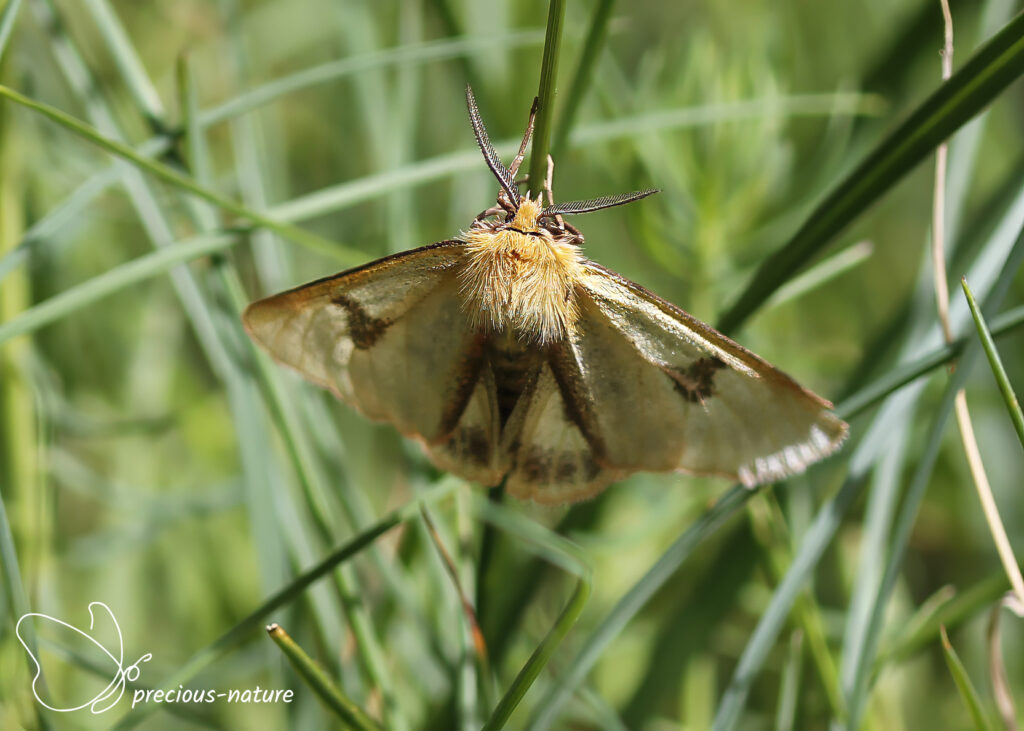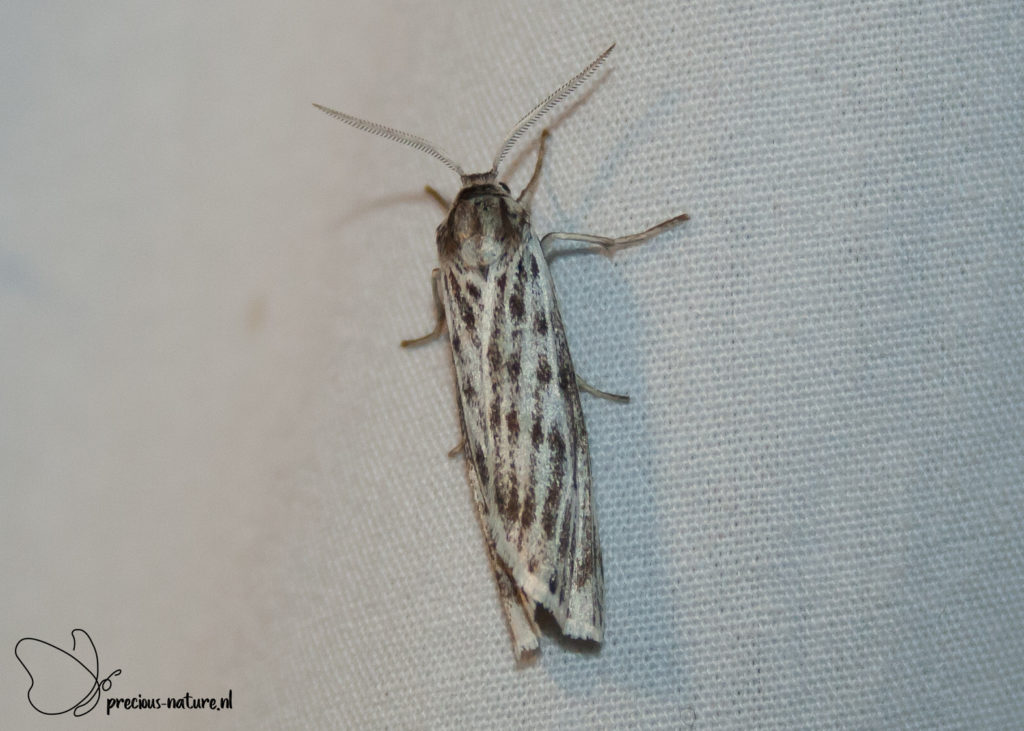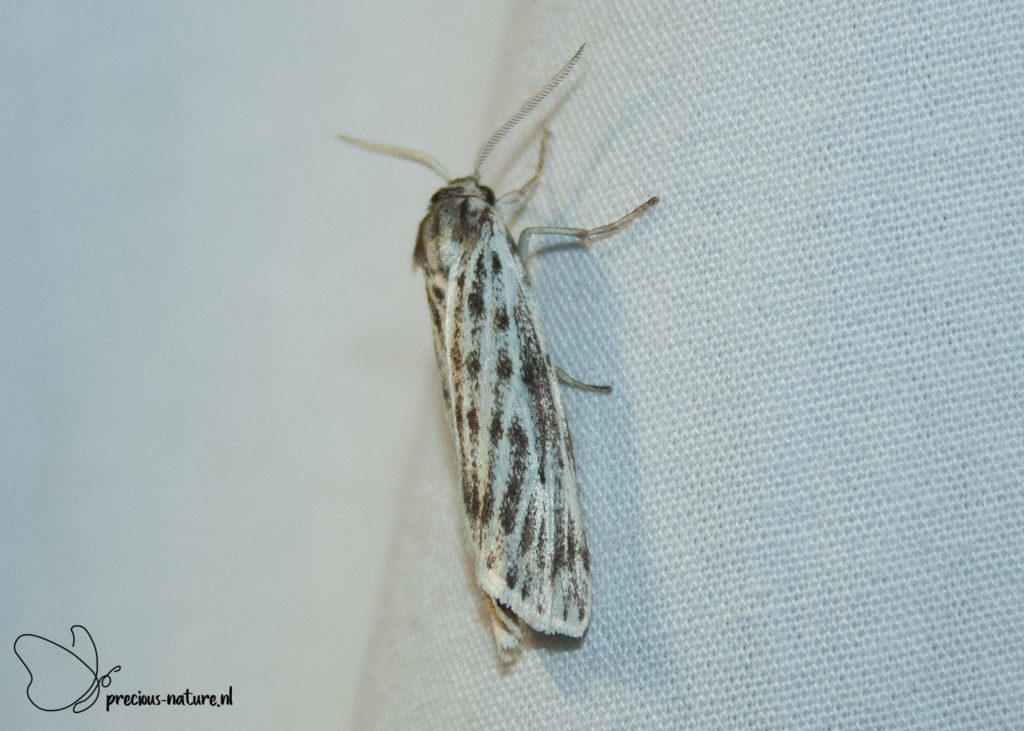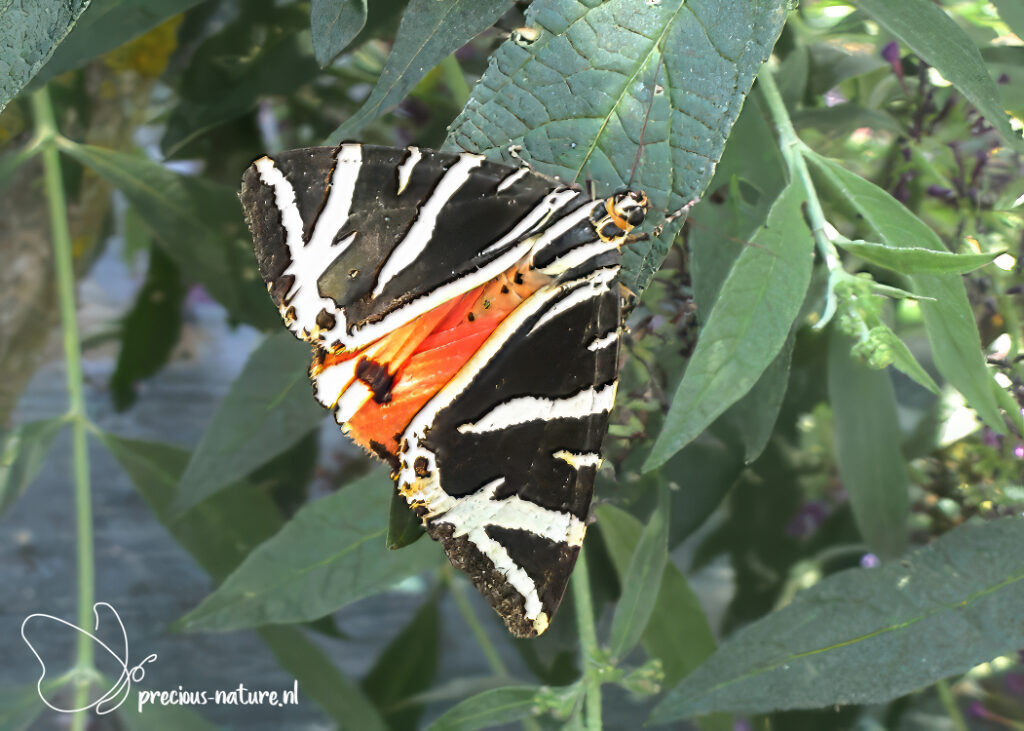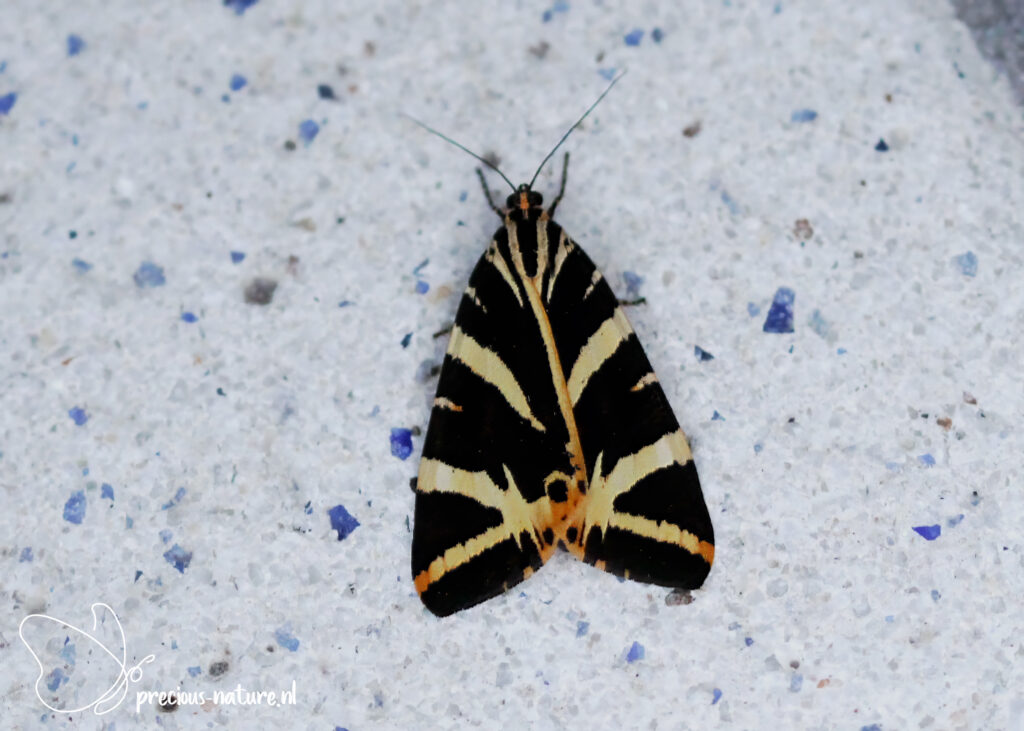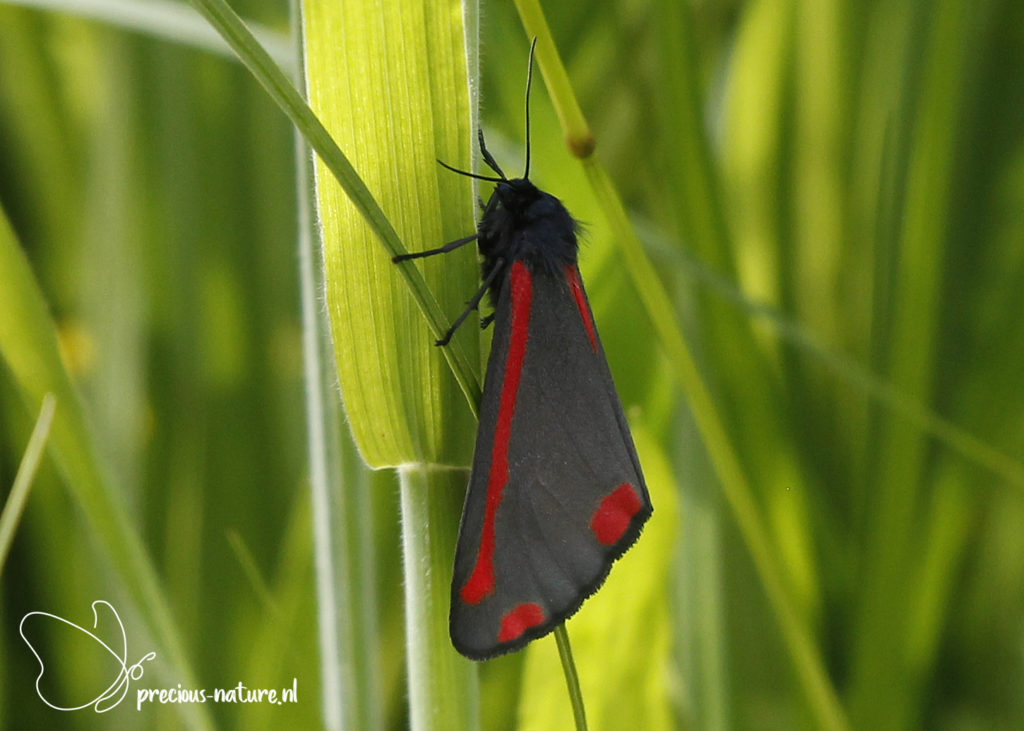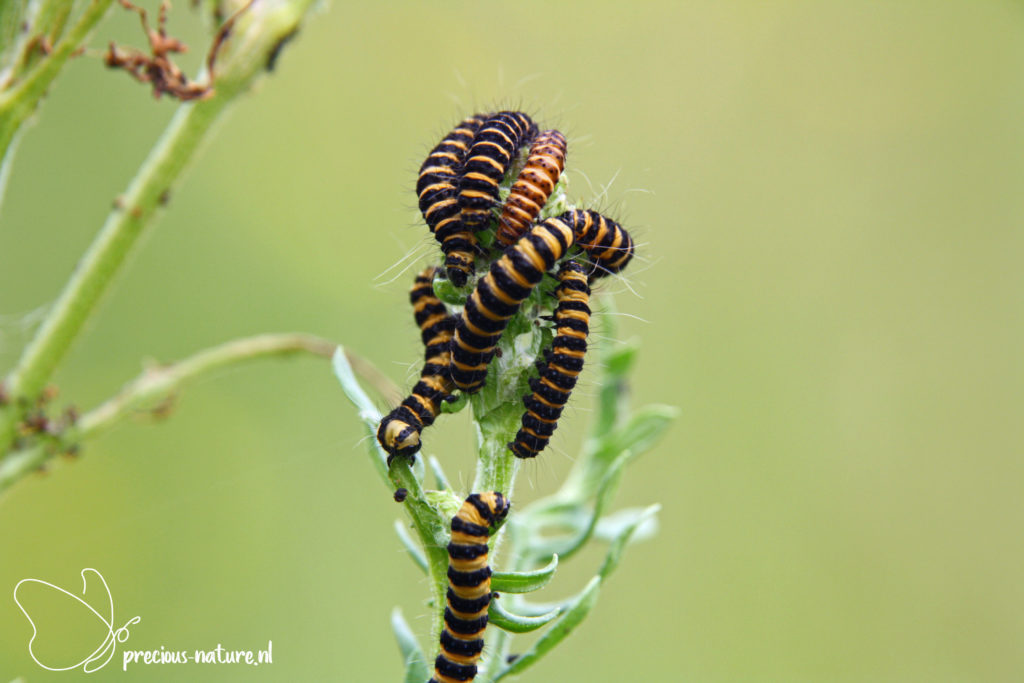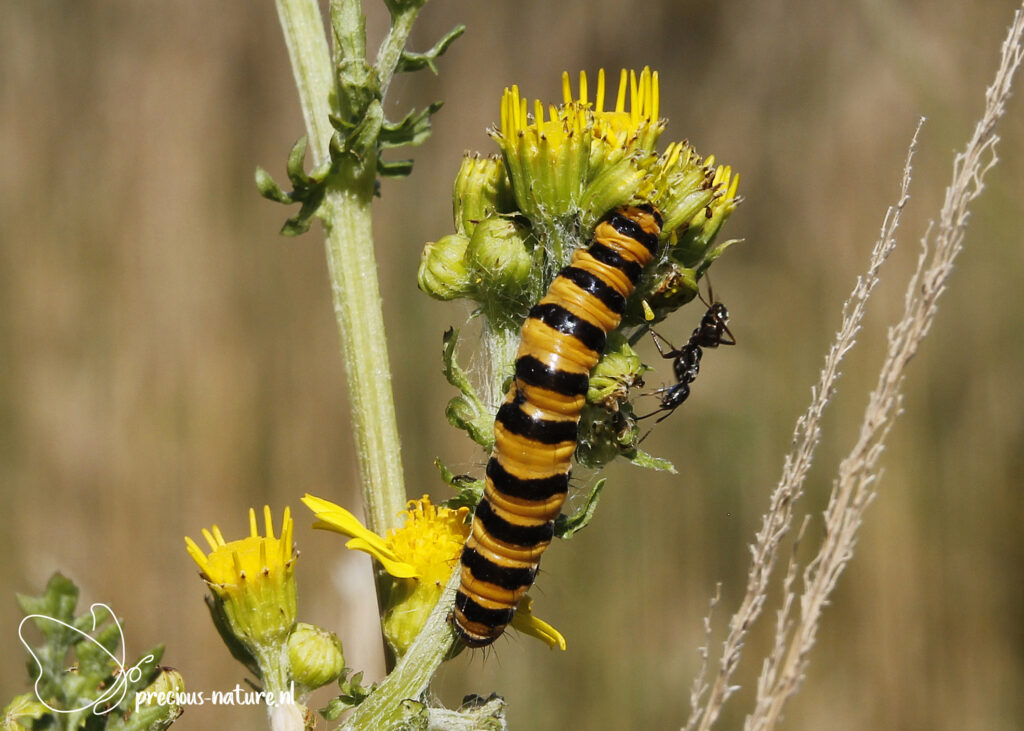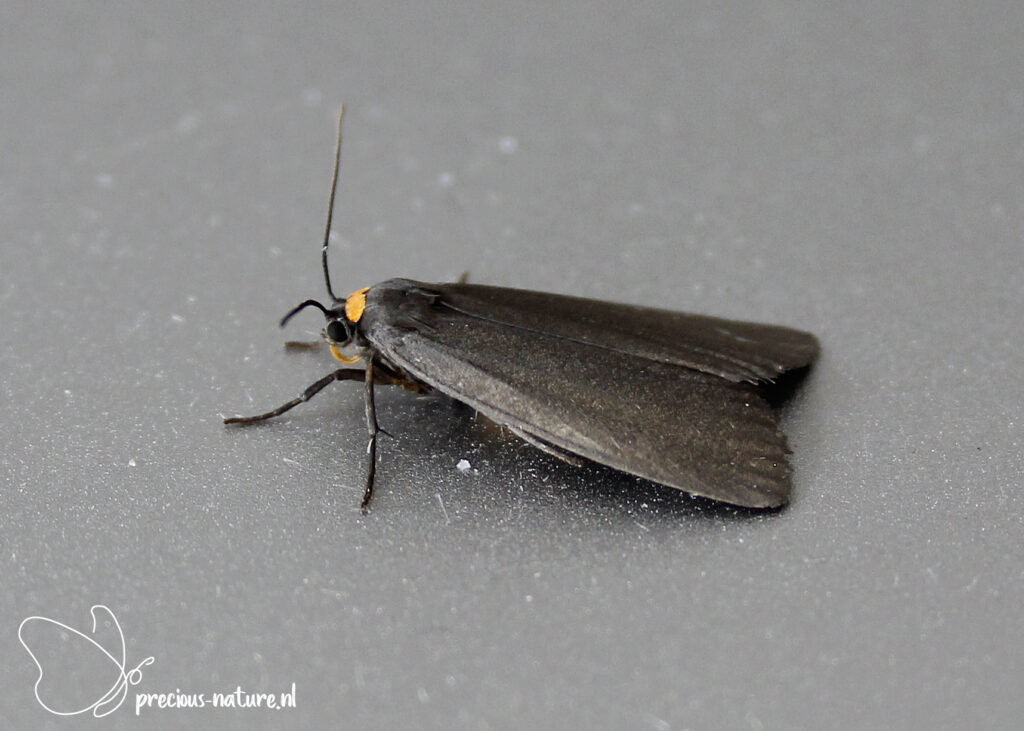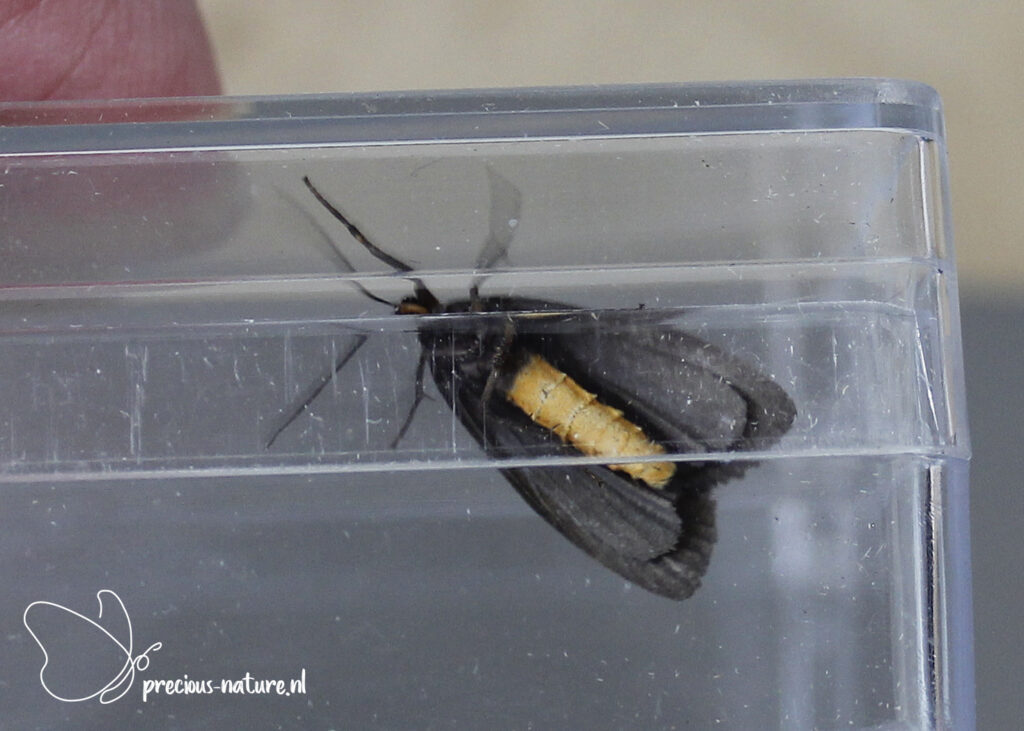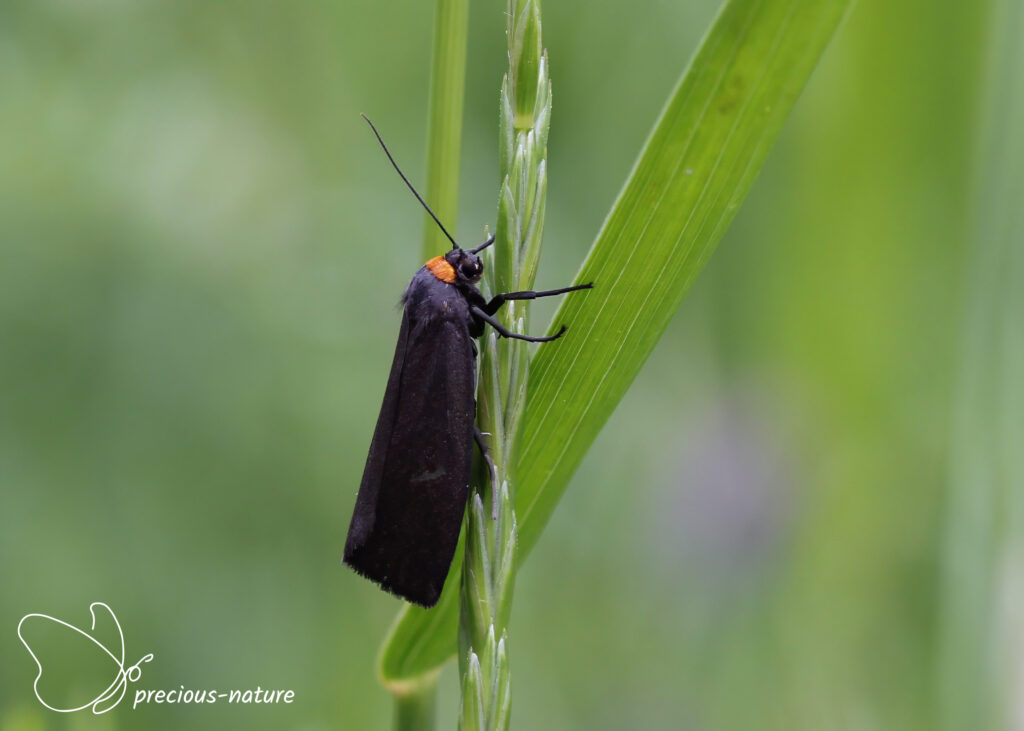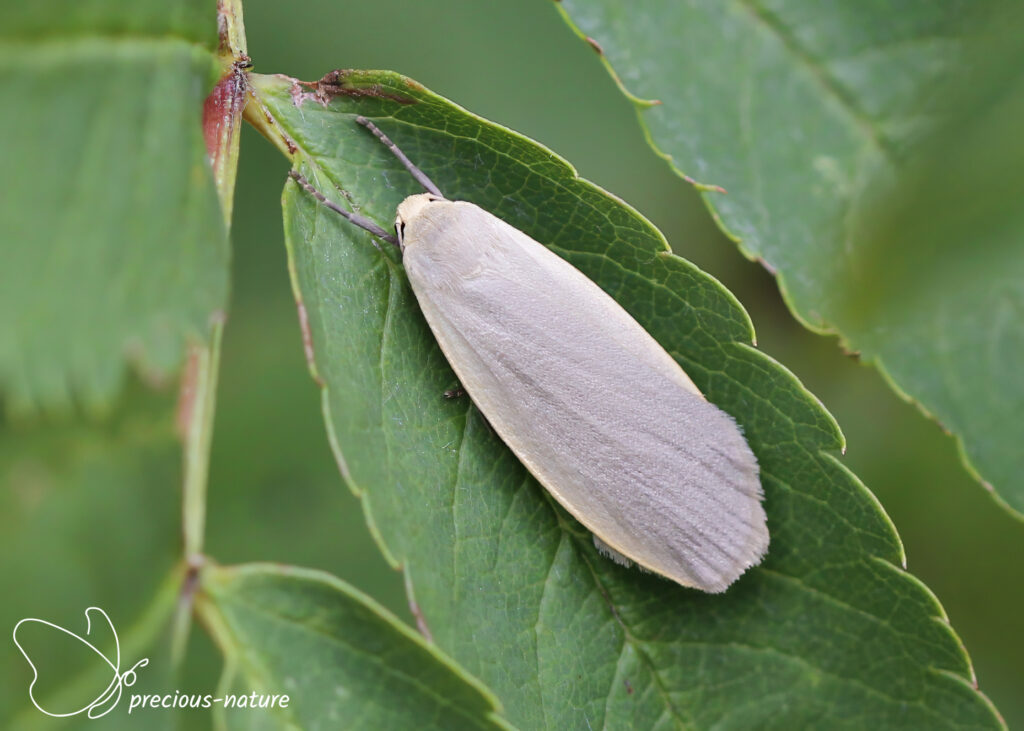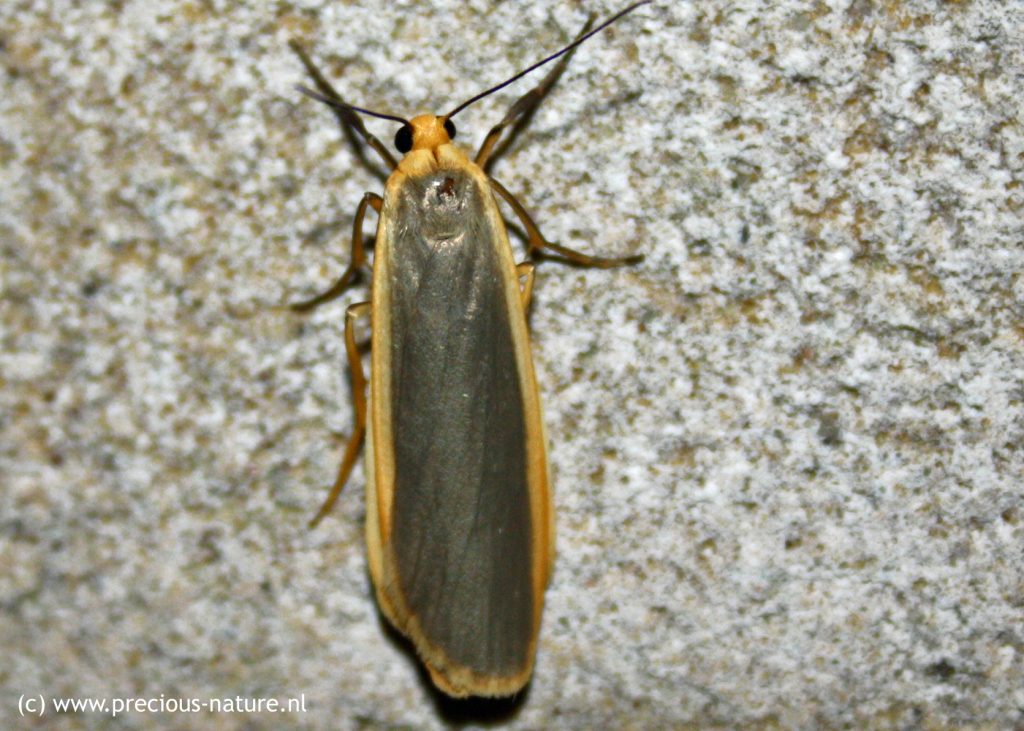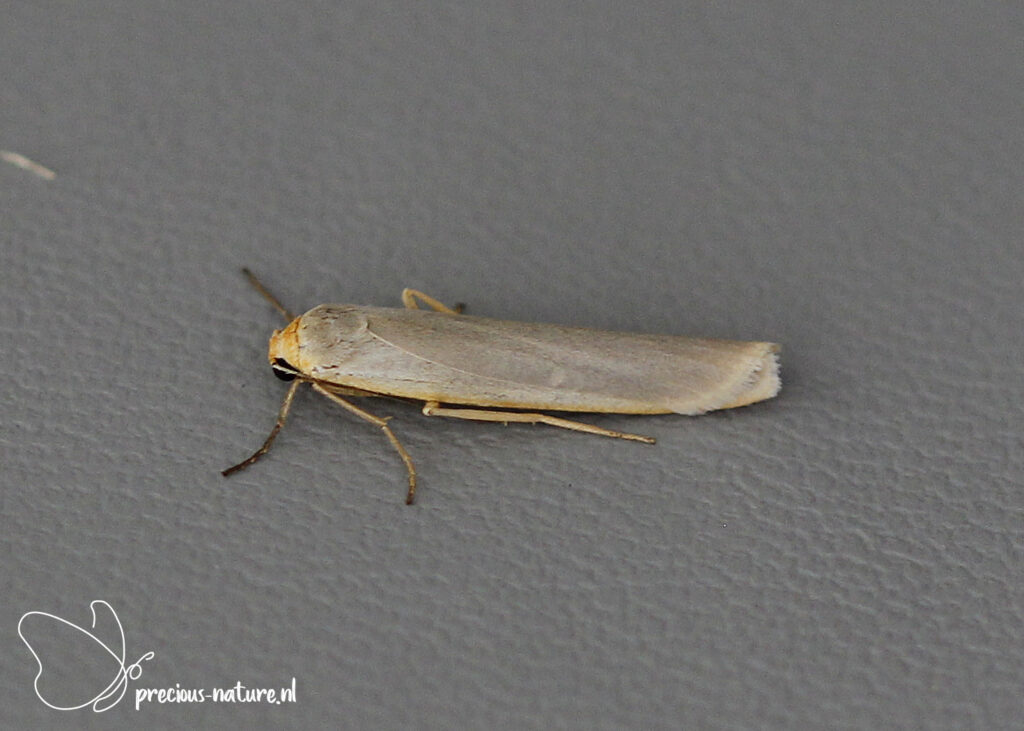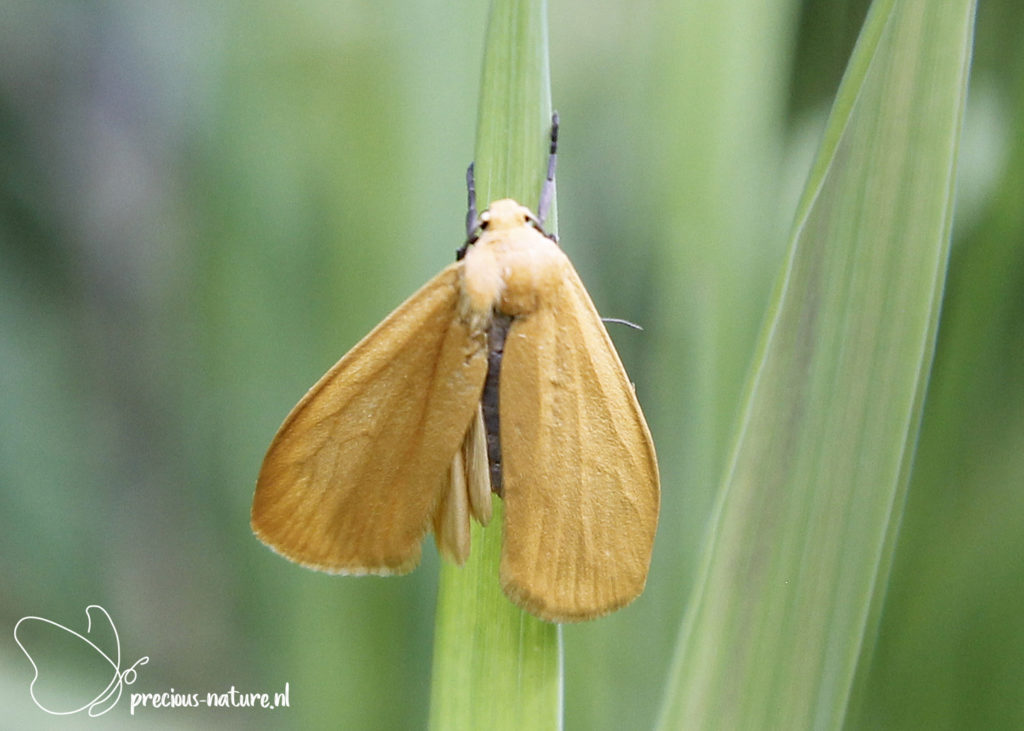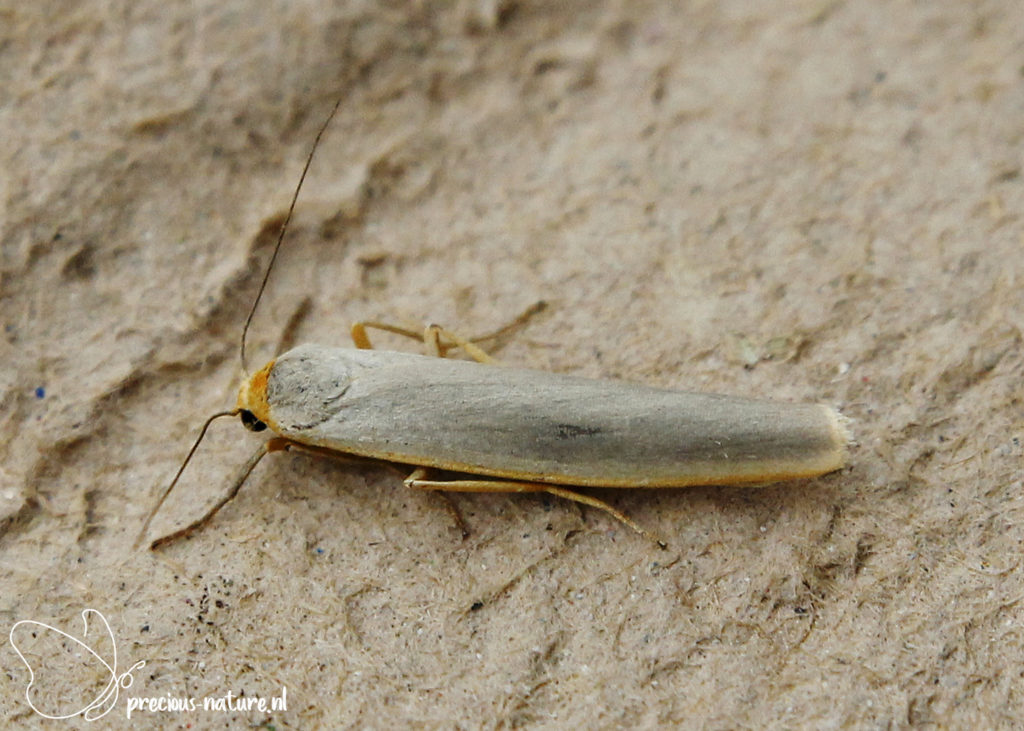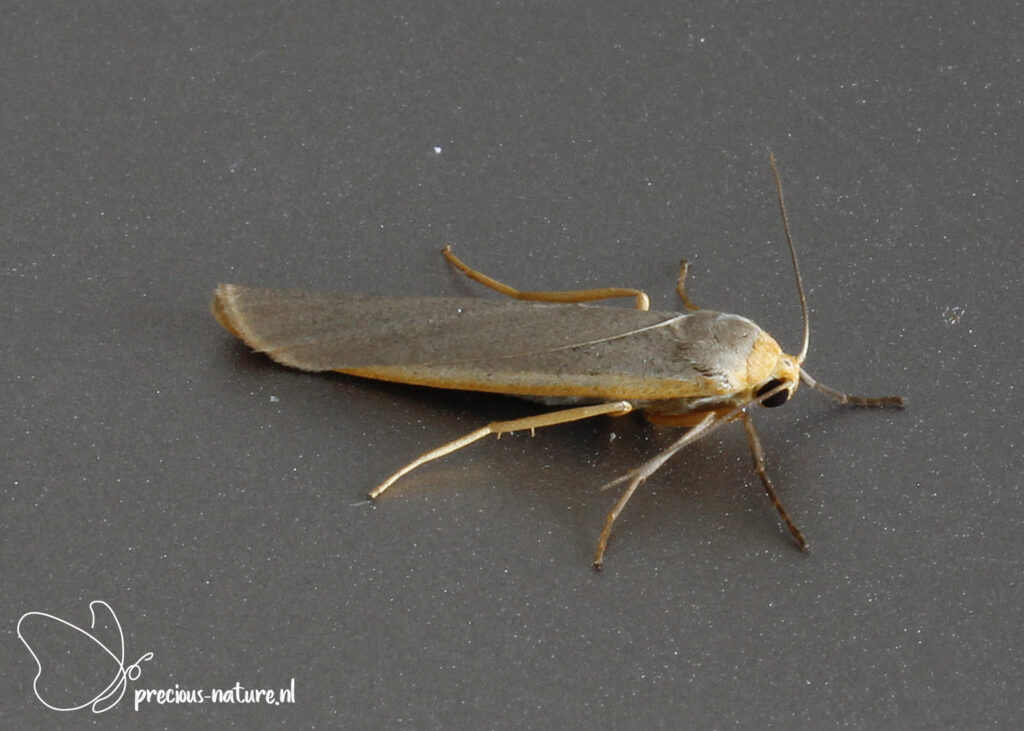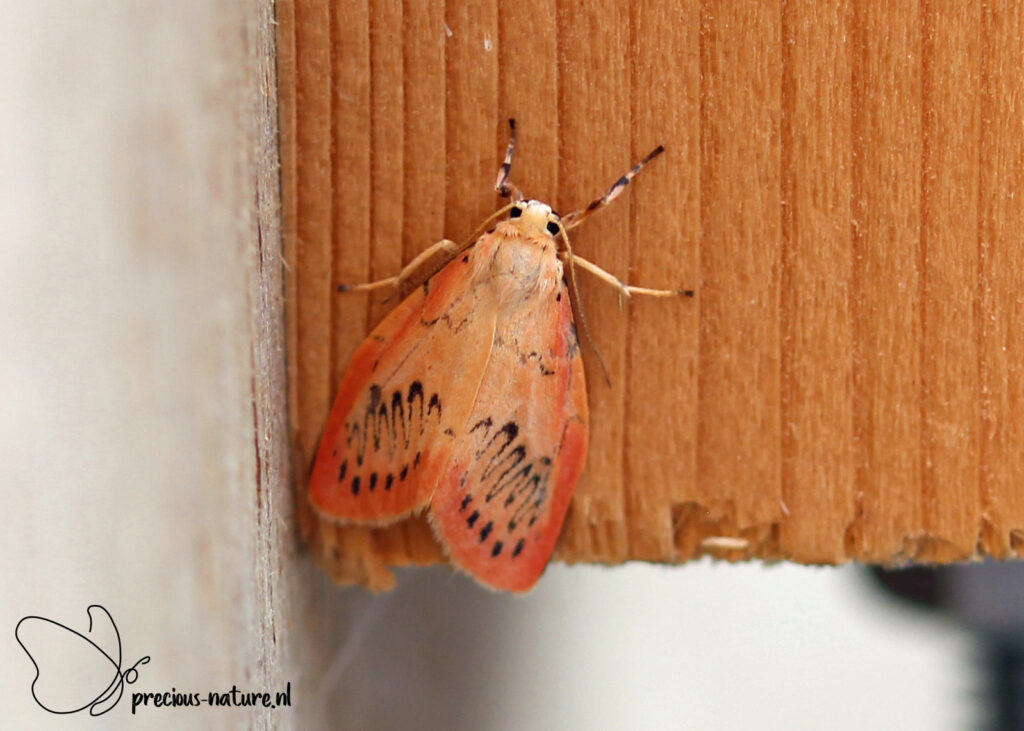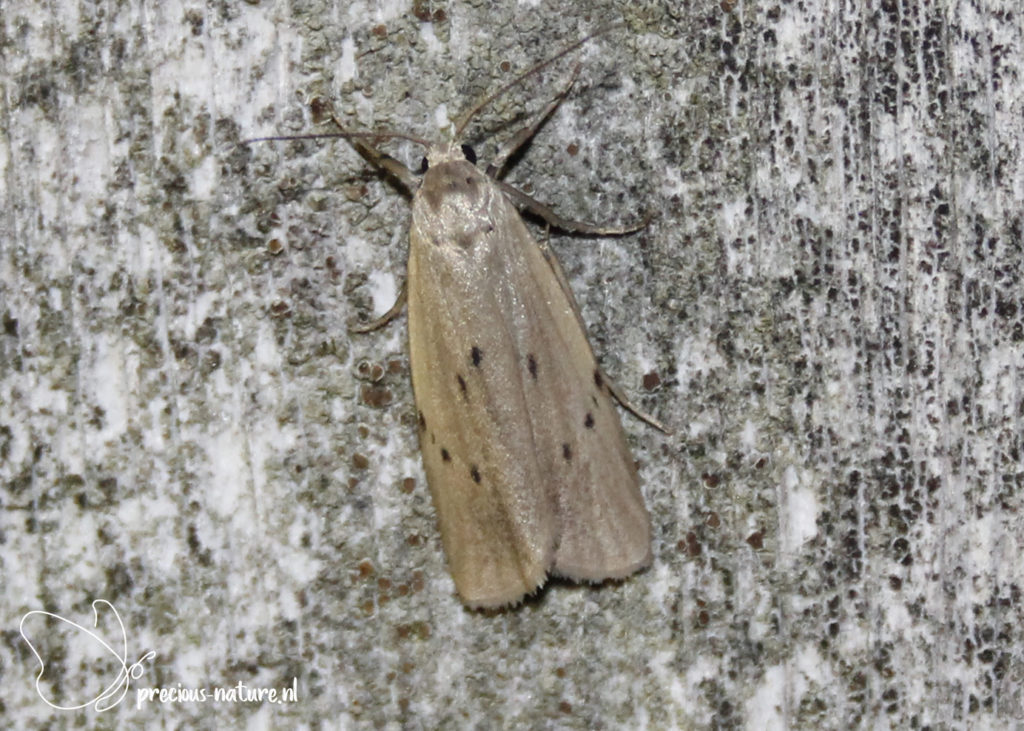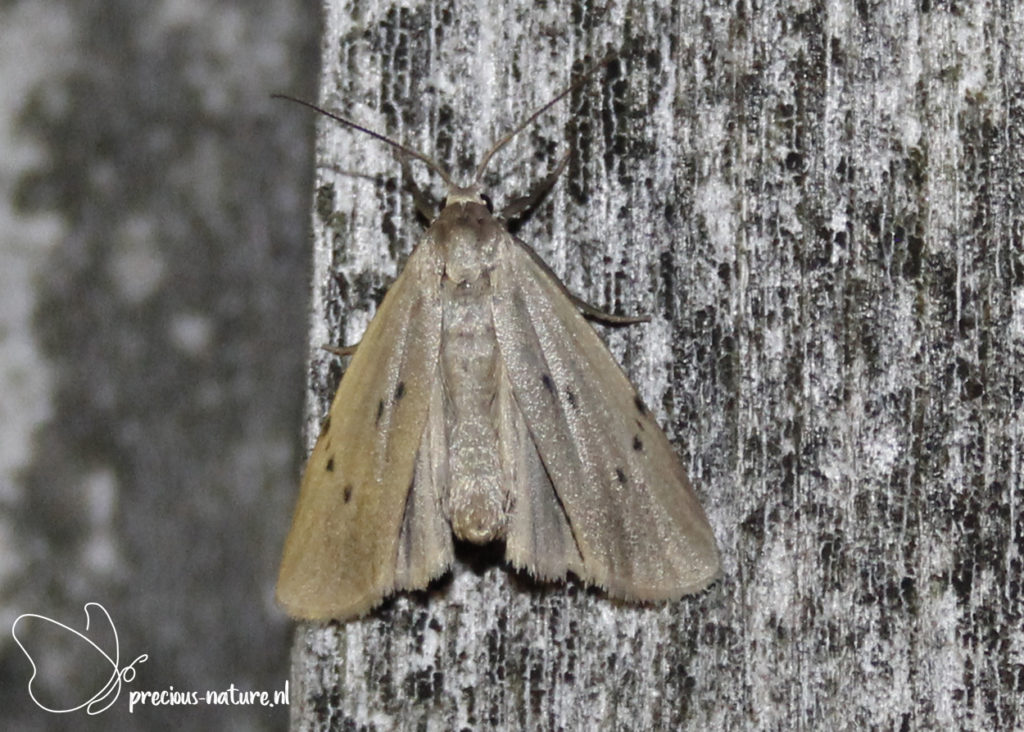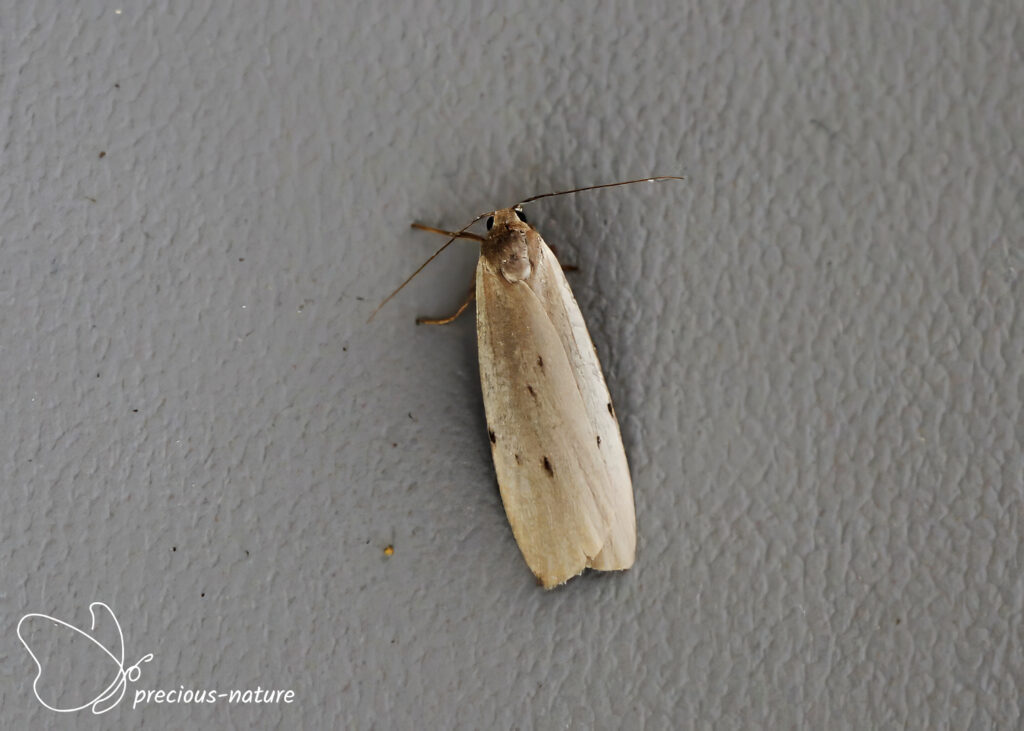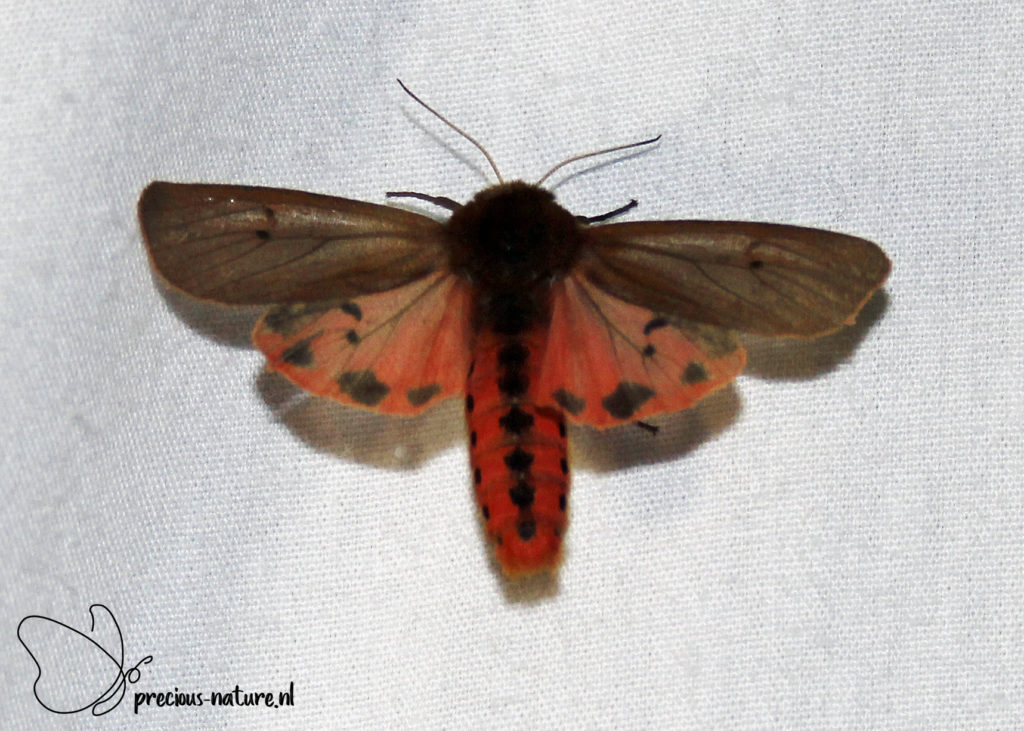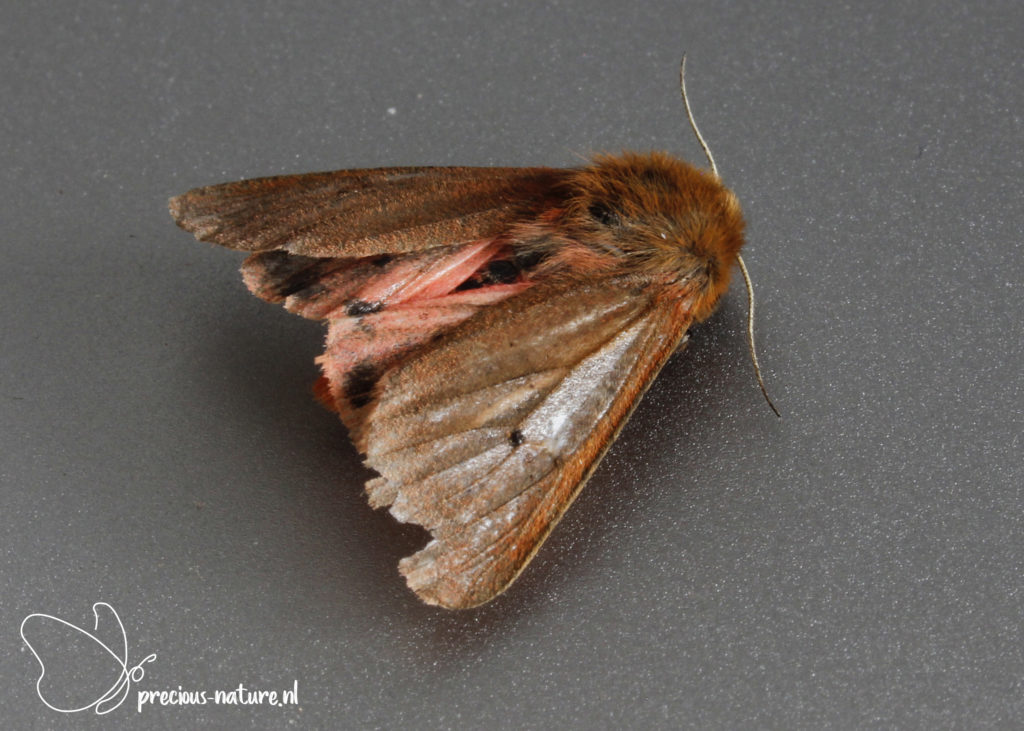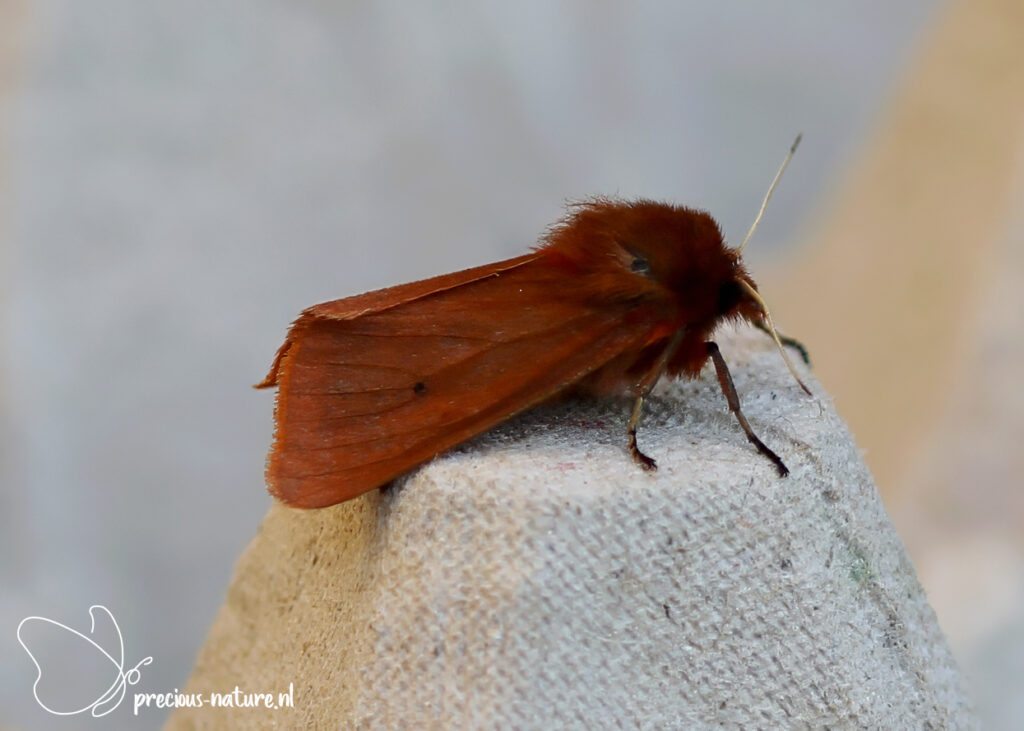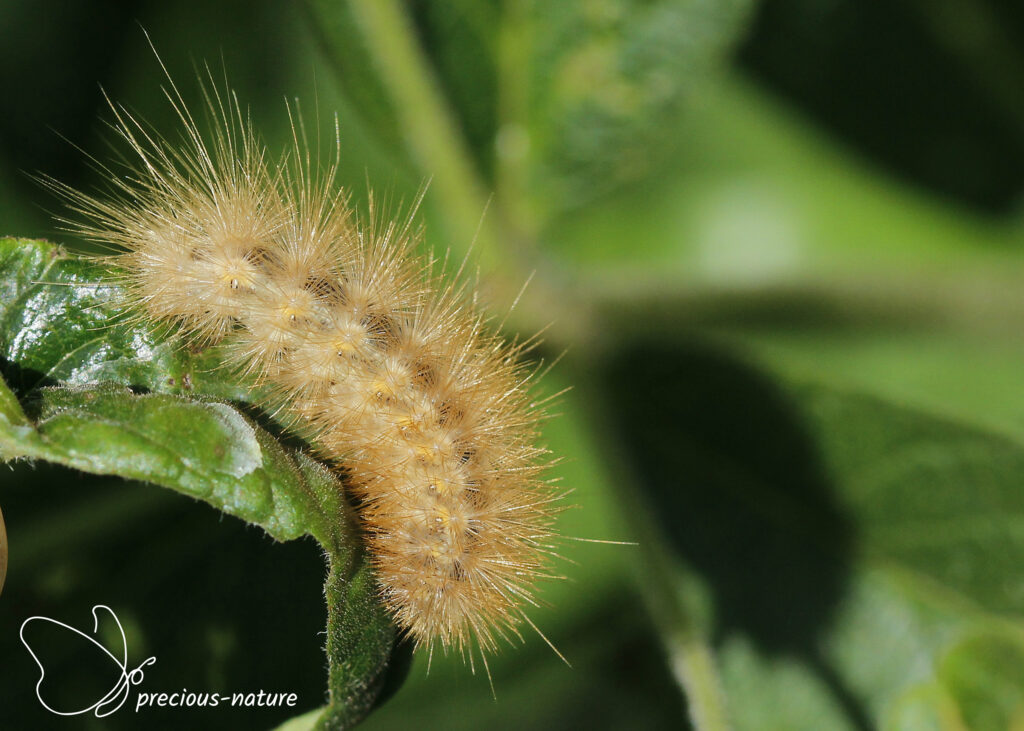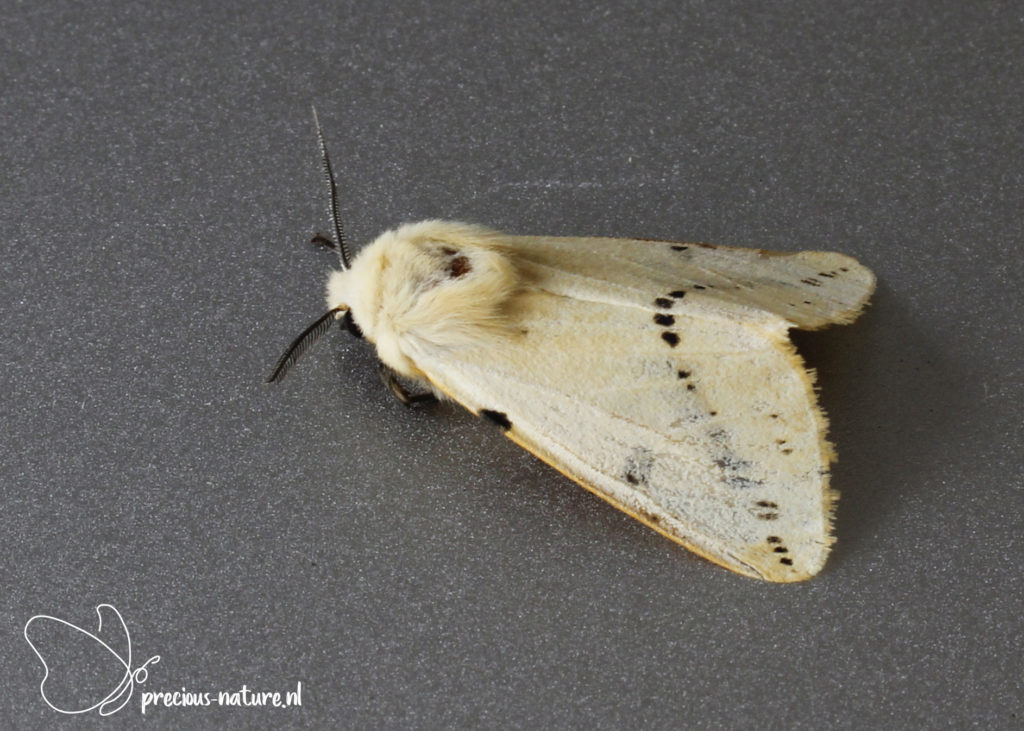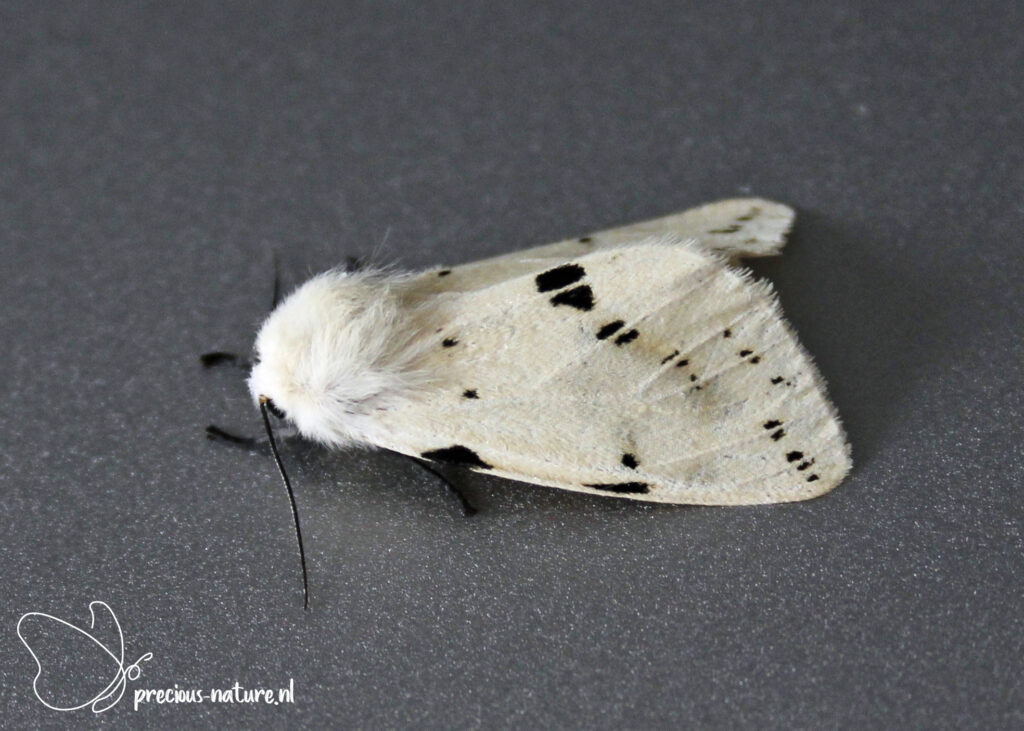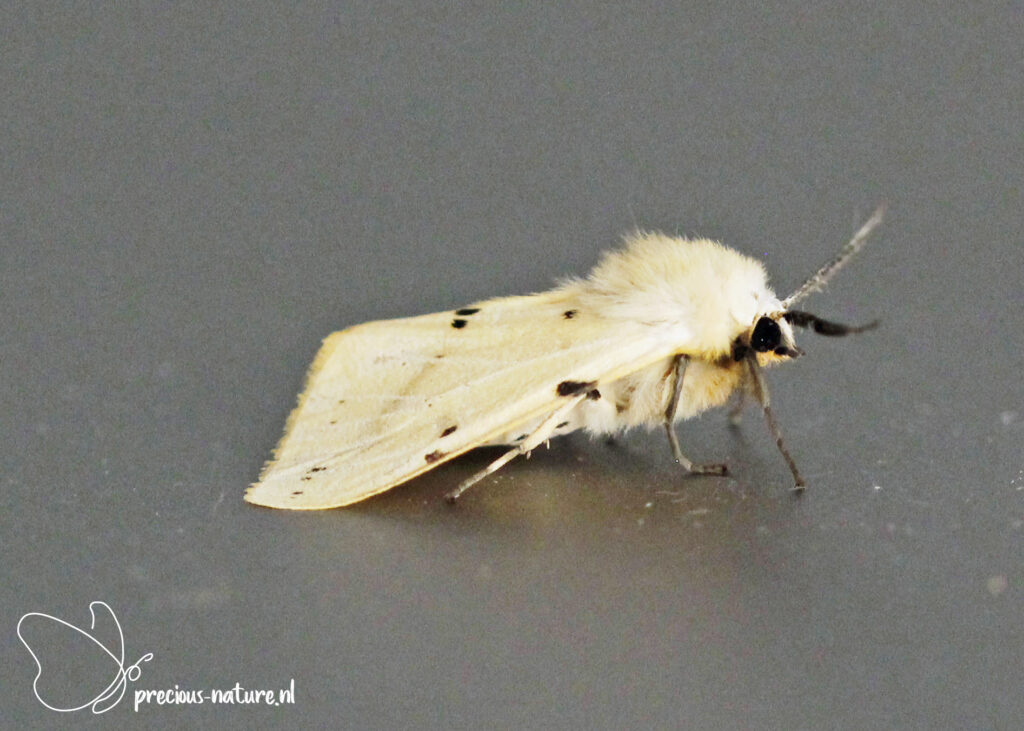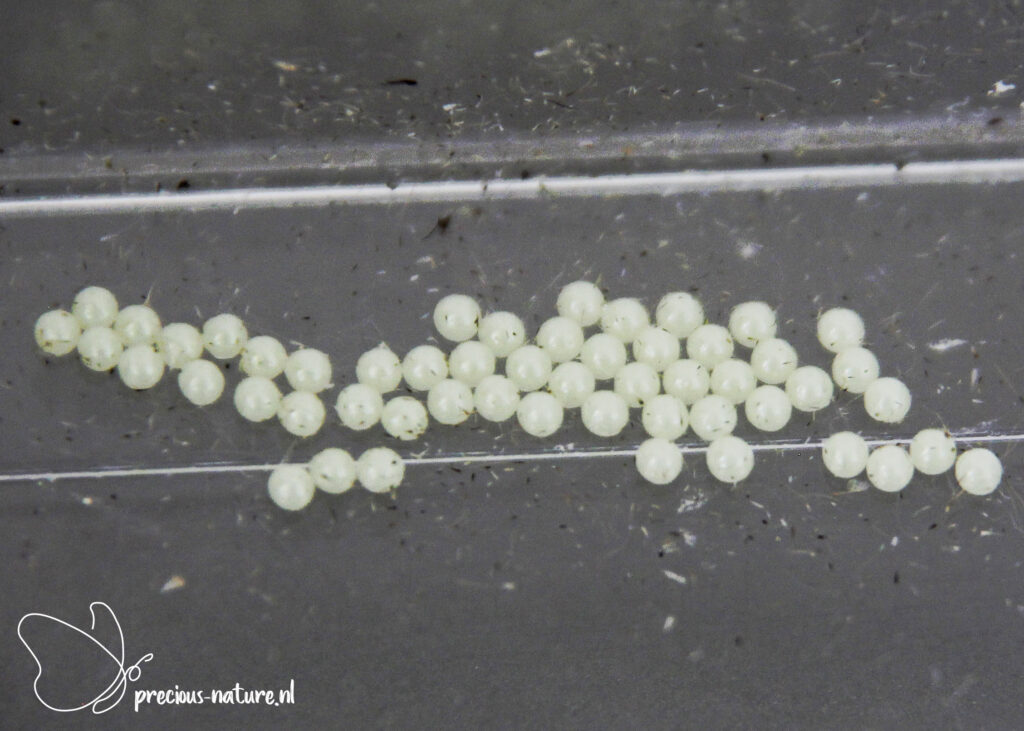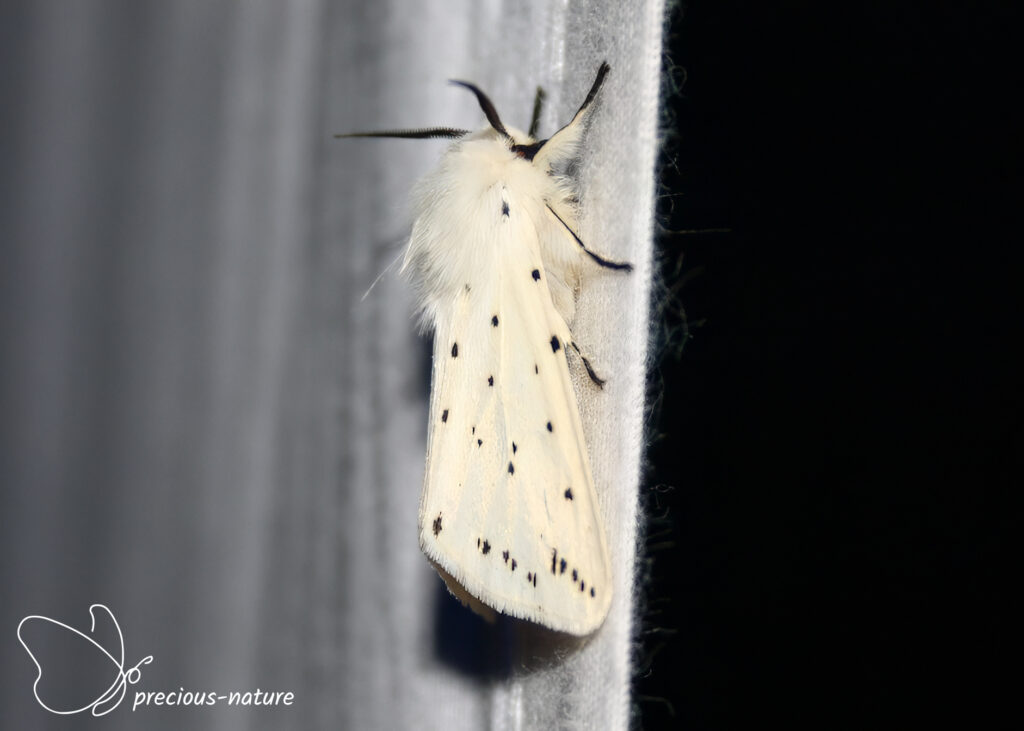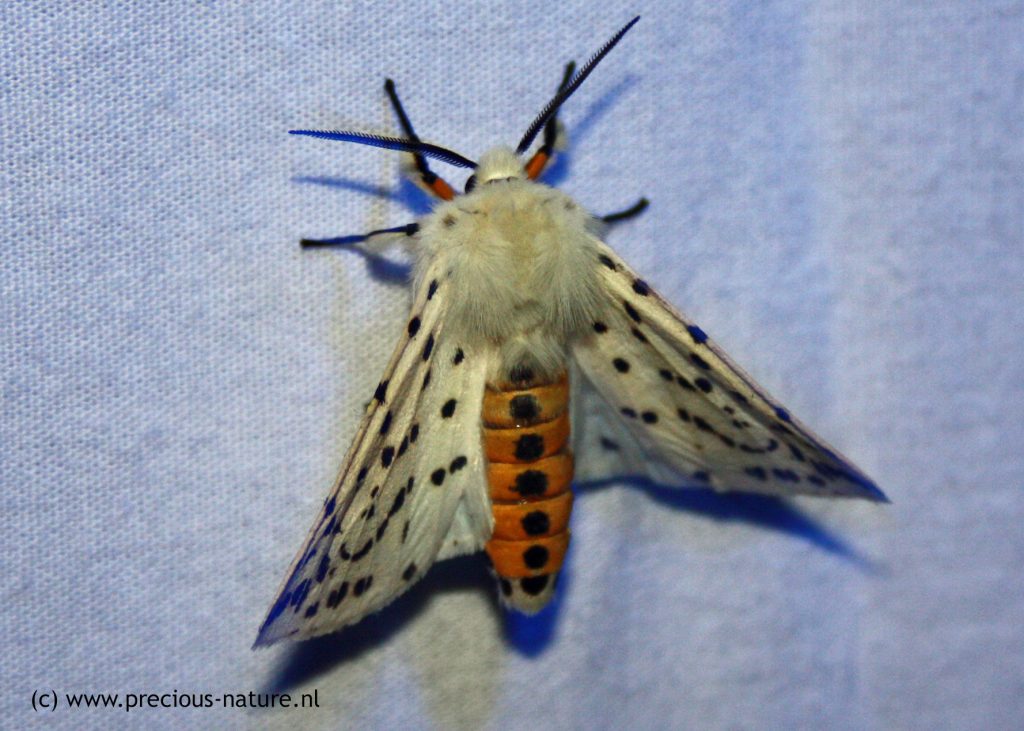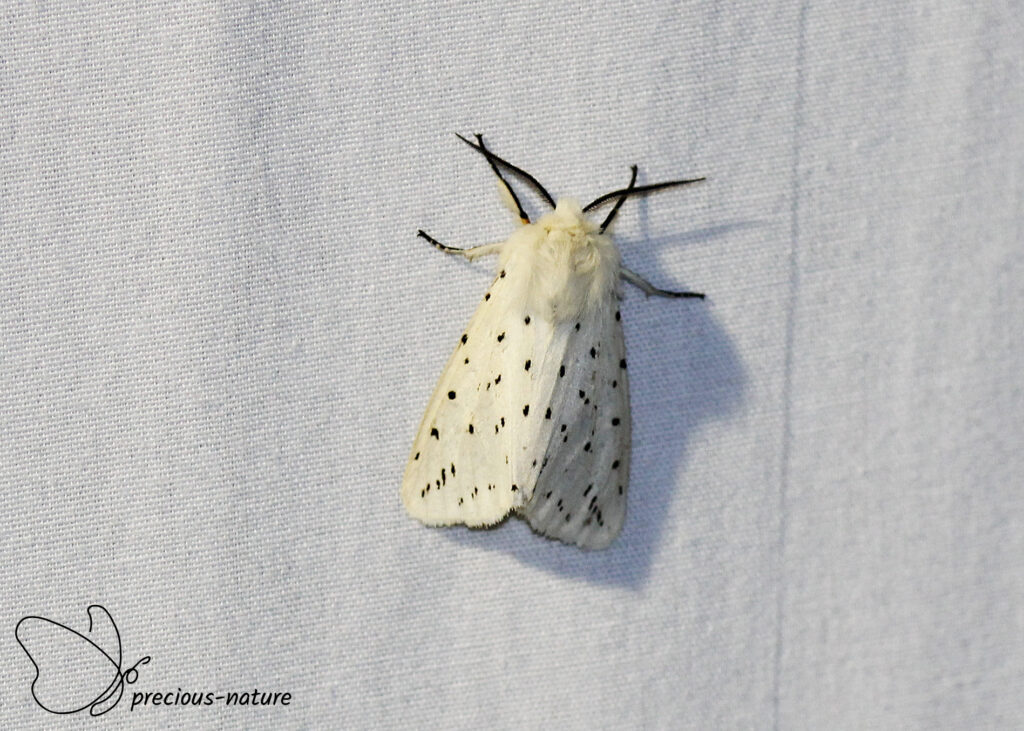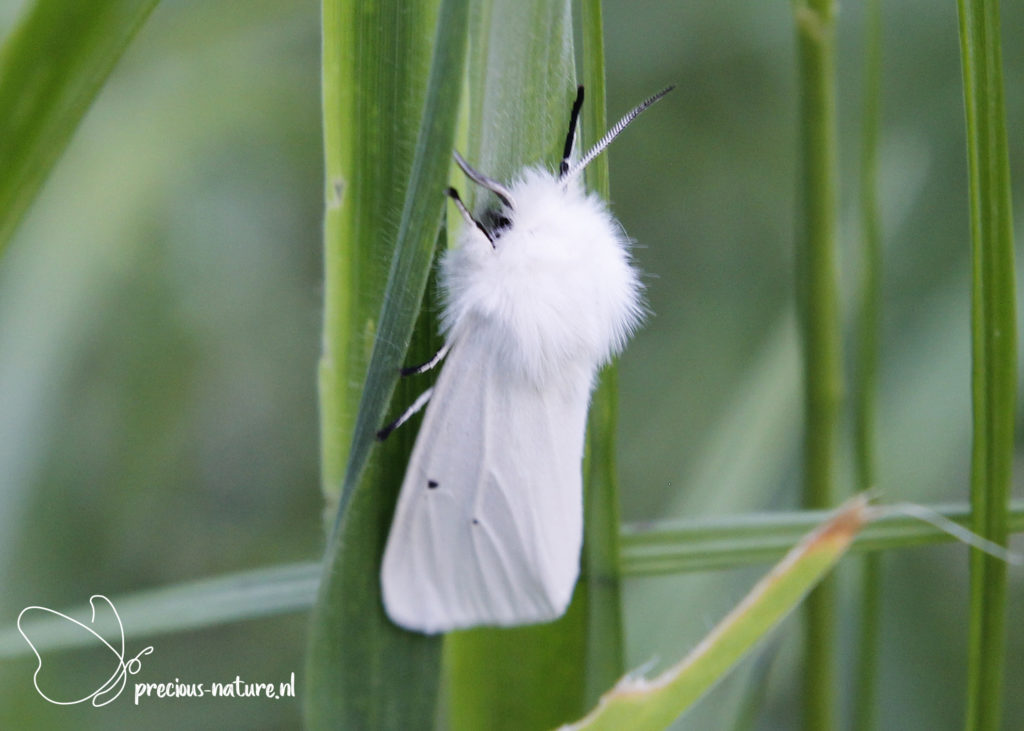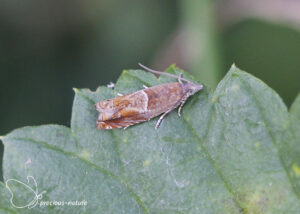Tiger Moths (Arctiinae) are a subfamily of the Erebid Moths (Erebidae). These sturdy butterflies have hairy bodies, sometimes with bright colours or many black spots. The forewings usually have a cryptic pattern; the hindwings have a contrasting pattern with bright colours. The moths use this to warn enemies about their toxicity and that they cannot be eaten. Tiger Moths use adapted hair cuticles to produce ultrasonic sounds, known as “clicks”. This allows them to draw attention to their bright colours, thereby mimicking the toxicity, reproducing sounds of other species, or even disrupting the echolocation of bats. These sound-making organs and their sound differ significantly between the different species. Most species fly at night and are attracted to light, but some fly in the early morning or during the day. Worldwide, about 14,000 species, of which about 40 have been recorded in the Netherlands.
Tribe: Arctiini
Genus: Arctia
Garden Tiger – 2010 (NL)
(NCBI-index: 289281)
The Garden Tiger (Arctia caja) can be recognised by the white with dark brown pattern on the forewing and the orange-red hindwing with blue-black spots. It can produce a clear yellow fluid from two ducts behind the head. It flies in one or sometimes two generations from June to September, and the wingspan is 50-78 mm. Host plant: Common Nettle, Broad-leaved Dock, Water Dock, Hound’s-tongue. Dutch name: Grote beer. Frisian name: Grutte bearflinter.
Flying period:

Tribe: Arctiini
Genus: Arctia
Wood Tiger – 2024 (CH)
(NCBI-index: 874455)
The Wood Tiger (Arctia plantaginis) is rare in the Netherlands and sometimes seen in the extreme south (Limburg). The colour is variable, but always easy to recognise by the striking yellow longitudinal stripe along the inner edge of the forewing. The hindwing of the male is yellow or white with black stripes and spots. The hindwing is more orange-yellow or red with black spots and stripes in females. A thin, striking yellow line is visible along the leading and trailing edges. The thorax is firmly hairy with alternating black and white stripes, and the collar has orange-yellow hairy spots. The flight period spans one generation, from May to August, and the wingspan ranges from 32 to 38 mm. Host plant: Plantain, Dandelion, Sorrel, Nettle. Dutch name: Weegbreebeer. Frisian name: –
Flying period:

Tribe: Arctiini
Genus: Diachrisia
Clouded Buff – 2017 (NL)
(NCBI-index: 464721)
I discovered the Clouded Buff (Diacrisia sannio) during the day while it was disturbed and came out of the long grass—a pleasant surprise due to the striking colours. The male has a yellow forewing with a red spot in the middle and a red stripe along the dorsum. The female has an orange forewing with red veins. The hindwing is white, with a black band along the termen and a red wing edge. For example, on the forewing, there is a spot in the centre, which is black. He flies in one generation from May to August and has a 34-44 mm wingspan. Host plant: Heather, Sheep’s Sorrel, Common Dog-violet. Dutch name: Roodbandbeer. Frisian name: Readbânbear.
Flying period:

Tribe: Callimorphini
Genus: Coscinia
Speckled Footman – 2019 (NL)
(NCBI-index: 938185)
It’s always nice to spot a new species at the moth sessions in my backyard. In that respect, 2019 was a good year—many new species, including the Speckled Footman (Coscinia cribraria). In the resting position, this moth folds its wings around its body so that the wingtips appear pointed. The greyish-white forewing has several dark transverse bands that consist of rows of blackish spots that are sometimes fused. The blackish streaks on the forewing can vary in number and size. The blackish streaks are much more prominent for the specimen islands than for coastal specimens. The hindwing is brownish-grey with whitish fringes. The flight period spans from June to September in one generation, and the wingspan ranges from 30 to 35 mm. Host plant: Heather, Blueberry. Dutch name: Grasbeertje. Frisian name: –
Flying period:

Tribe: Callimorphini
Genus: Euplagia
Jersey Tiger – 2006 (NL)
(NCBI-index: 987932)
The Jersey Tiger (Euplagia quadripunctaria) is an easily recognisable butterfly because of the green-black forewing with cream-coloured stripes and red, orange, or yellow hindwing. It flies both in the daytime when it can be found feeding on various flowers, and at night, when it is attracted to light. This moth flies in one generation from July to the end of August, and the wingspan is 52-65 mm. Host plant: Common Nettle, Hemp-agrimony, Borage, Ground-ivy, Bramble. Dutch name: Heravlinder or Spaanse vlag. Frisian name: –
Flying period:

Tribe: Callimorphini
Genus: Tyria
Cinnabar Moth – 2022 (NL)
(NCBI-index: 179666)
Although I have often seen the caterpillars of the Cinnabar Moth (Tyria jacobaeae), I could not discover the butterfly until 2022. This diurnal moth has a striking appearance due to the black forewing with two red dots along the rear edge and a red stripe along the leading and trailing edges. The hindwing is solid red with a dark fringe. Sometimes, this moth is confused with the Six-spot Burnet (Zygaena filipendulae), which belongs to the Burnet family. The drawing of the wings, which also has black and red spots, is quite different. The flight period spans from early April to mid-August in one generation, and the wingspan ranges from 32 to 42 mm. Host plant: Ragwort. Dutch name: Sint-jacobsvlinder. Frisian name: Sint-jabiksflinter.
Flying period:

Tribe: Lithosiini
Genus: Atolmis
Red-necked Footman – 2022 (NL)
(NCBI-index: 987889)
This moth is unmistakable, as no other species has solid black wings and a red collar. The Red-necked Footman (Atolmis rubricollis) has long, narrow wings folded around the body, making it resemble a servant in Victorian times. The wings are velvet black in fresh specimens, and the collar is red. The red colour becomes more orangish as the moth ages. The abdomen is orange-yellow except for the front part of the top. The flight period is one generation from mid-May to mid-July, and the wingspan is 25-35 mm. Host plant: (lichen) mosses and algae on trees and shrubs. Dutch name: Zwart beertje. Frisian name: Swart bearke.
Flying period:

Tribe: Lithosiini
Genus: Eilema
Dingy Footman – 2017 (NL)
(NCBI-index: 987420)
The Dingy Footman (Eilema griseola) is a relatively narrow, elongated butterfly that has folded its wings in a resting position. The wings are yellowish or grey. The grey specimens have a narrow yellow stripe along the costa, and the black legs are striking. They fly at night but can be spotted resting on the leaves of deciduous trees during the day. That’s where I’ve seen them so far. He flies in one or two generations from June to October, and the wingspan is 32-40 mm. Host plant: Mosses and algae on trees. Dutch name: Glad beertje. Frisian name: Glêd bearke.
Flying period:

Tribe: Lithosiini
Genus: Eilema
Common Footman – 2018 (NL)
(NCBI-index: 987421)
The Common Footman (Eilema lurideola) is not precisely the moth I expected in my backyard. It is more of a moth found in wooded areas. The front wing is lead grey with a clear yellow stripe along the costa. In the direction of the apex, it gets thinner and thinner. The hind legs are mainly yellow, distinguishing it from the Buff Footman (Eilema depressa). The hindwing is light yellow and is folded under the forewing in a resting position. The flight period is from June to September in one generation, and the wingspan is 28-34 mm. Host plant: Lichens and algae on trees, stones, and posts, sometimes leaves of Hawthorn, Blackthorn, and Blackberry. Dutch name: Plat beertje. Frisian name: –
Flying period:

Tribe: Lithosiini
Genus: Eilema
Hoary Footman – 2018 (NL)
(NCBI-index: 987929)
A tiger moth that keeps its wings in a tube around its body in a resting position is the Hoary Footman (Eilema caniola). This moth loves warmth and needs warm weather to develop. That is increasingly the case in Northern Europe, which could be why he is spotted more often in the Netherlands. The forewing is narrow and very light grey. A pale yellow border is visible along the costa. The hindwing is white, unlike the Scarce Footman (Eilema complana), which can be easily confused with this species. The flight period spans two generations, from late May to September, and the wingspan ranges from 28 to 35 mm. Host plant: Mosses, algae, clover. Dutch name: Vaal kokerbeertje. Frisian name: –
Flying period:

Tribe: Lithosiini
Genus: Eilema
Orange Footman – 2020 (NL)
(NCBI-index: 987424)
The shape of the wings of the Orange Footman (Eilema sororcula) is characteristic of the species within its family. The costa is straight up to 2/3 and then strongly bends towards the apex. The wing has a striking orange-yellow colour that slightly becomes paler as the moth ages. The wingspan is 27-30 mm, and the flight period is from April to July for one generation. Host plant: Mosses on Oak, Beech, Blackthorn. Dutch name: Geel beertje. Frisian name: Giel bearke.
Flying period:

Tribe: Lithosiini
Genus: Eilema
Scarce Footman – 2020 (NL)
(NCBI-index: 987418)
When checking the moth trap, I discovered the Scarce Footman (Eilema complana). The grey forewing has an orange-yellow stripe along the costa that is the same width over the entire length. Striking is the orange-yellow collar, which also distinguishes it from the resembling Common Footman (Eilema lurideola). The Common Footman has a grey spot in the orange-yellow collar. In addition, the Scarce Footman rests its wings in a tube around the body, whereas the Common Footman rests with the wings flat above the body. Another similar moth is the Hoary Footman (Eilema caniola). Where the Hoary Footman has a white hindwing, the Scarce Footman has a pale yellow hindwing with sometimes a grey streak. The wingspan is 28-35 mm, and the flight period is from June to September for one generation. Host plant: Mosses on stones, poles, and branches on the ground. Dutch name: Streepkokerbeertje. Frisian name: –
Flying period:

Tribe: Lithosiini
Genus: Miltochrista
Rosy Footman – 2023 (BE)
(NCBI-index: 987980)
The Rosy Footman (Miltochrista miniata) is an easily recognisable diurnal moth. It is an unmistakable small butterfly with salmon-coloured wings. Very rarely, the wings are uniformly yellow. The rounded forewings show a fine, deeply serrated transverse line slightly beyond the centre and a row of dark spots or dots near the trailing edge. The edges of the wing are also usually coloured darker than the rest of the wing. The flight period is one or two generations from early June to mid-September, and the wingspan is 23-27 mm. Host plant: lichens on trees, especially oak. Dutch name: Rozenblaadje. Frisian name: Roazebledsje.
Flying period:

Tribe: Lithosiini
Genus: Pelosia
Dotted Footman – 2020 (NL)
(NCBI-index: 988016)
The Dotted Footman (Pelosia muscerda) is a relatively slender, soft grey-brown forewing moth. The costa is often a bit lighter in colour. This moth’s characteristic is the pattern of five, sometimes six, tiny black dots seen in two separate rows on the forewing. The wings are often folded over each other in a resting position. The flying period is from June to September, and the wingspan is 24-28 mm. Host plant: Lichens and algae. Dutch name: Muisbeertje. Frisian name: Mûsbearke.
Flying period:

Tribe: Spilosomini
Genus: Phragmatobia
Ruby Tiger – 2017 (NL)
(NCBI-index: 214311)
The difference between the Ruby Tiger (Phragmatobia fuliginosa) and the Garden Tiger (Arctia caja) is that the Ruby Tiger is much smaller. The top of the forewing is reddish-brown, and two tiny dark dots can be distinguished on each wing. The hindwing is bright red, as is the top of the two hind legs, and has some dark spots. He flies at night and is attracted to light very well. It flies in two generations from April to September, and the wingspan is 28-34mm. Host plant: Ragworts, Plantains, Heather, Dock, Dandelion, Spindle, Broom. Dutch name: Kleine beer. Frisian name: Lytse bearflinter.
Flying period:

Tribe: Spilosomini
Genus: Spilaractia
Buff Ermine – 2017 (NL)
(NCBI-index: 875881)
The Buff Ermine (Spilosoma lutea) is a moth that I attracted to a light source. The male has a yellowish ground colour and the female a white one. Both have elongated spots that extend from the apex over the wing to the inner edge. From the top, this looks like a “clock” shape. The difference with the White Ermine (Spilosoma lubricipeda) is the number of black spots, which is much lower than that of the Buff Ermine. He flies in one generation from April to September, and his wingspan is 34-44 mm. Host plant: Common Nettle, Honeysuckle, Hops, Birch. Dutch name: Gele tijger. Frisian name: –
Flying period:

Tribe: Spilosomini
Genus: Spilosoma
White Ermine – 2018 (NL)
(NCBI-index: 875880)
A moth that belongs to the Tiger Moth is the White Ermine (Spilosoma lubricipeda). Previously, this butterfly was also called the ten o’clock butterfly because it was only seen after 10 p.m. The white forewing has a pattern of small black spots with at least one central black spot visible. The number of black spots can vary greatly, sometimes forming streaks along the wing veins. The head is very hairy, and the abdomen is bright yellow on top, with black spots on both sides. The flight period spans one generation, from May to August, and the wingspan ranges from 36 to 46 mm. Sometimes, there is a second generation from September to October. Host plant: Sorrel, Common Nettle, Elder. Dutch name: Witte tijger. Frisian name: Tsienoereflinter.
Flying period:

Tribe: Spilosomini
Genus: Spilosoma
Water Ermine – 2020 (NL)
(NCBI-index: 988039)
In a wetland environment, I saw the striking white Water Ermine (Spilosoma urticae) sitting on a green grass stem. The milky-white forewing is elongated, with one black dot in the centre. Sometimes, two or a small row of dots can be seen at the apex. The hindwing is solid white, and both antennas are whitely pollinated. The Water Ermine resembles the White Ermine (Spilosoma lubricipeda), but the latter usually has many more black dots on the forewing and a black dot on the hindwing. In addition, a characteristic difference is that the basal segment of the palps is yellow for the Water Ermine and not for the White Ermine. Another similar species is the Muslin moth (Diaphora mendica). The characteristic difference here is the abdomen. It is yellow for the Water Ermine and whitish or greyish brown for the Muslin moth. The flight period is from April to July in one generation, and the wingspan is 38-46 mm. Host plant: Water Dock, Water Mint. Dutch name: Sneeuwbeer. Frisian name: Sniebear.
Flying period:


